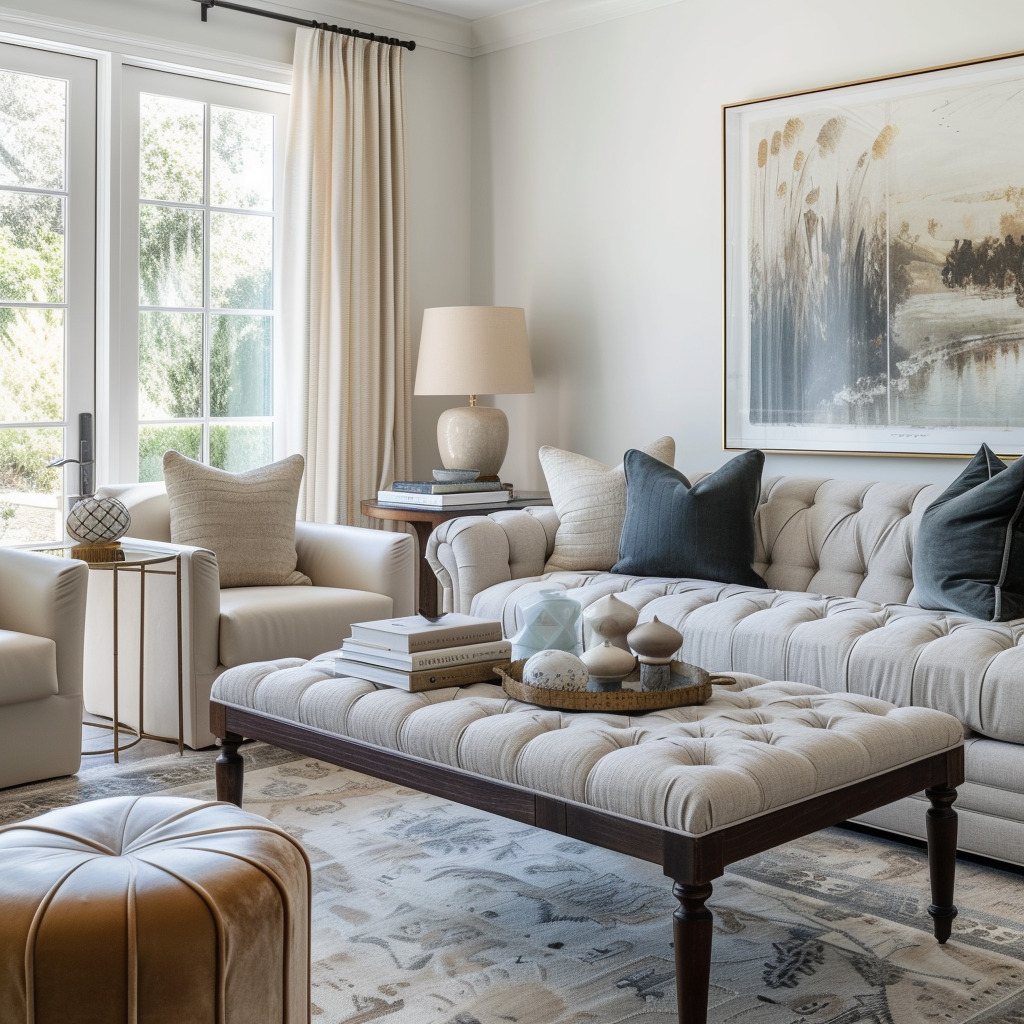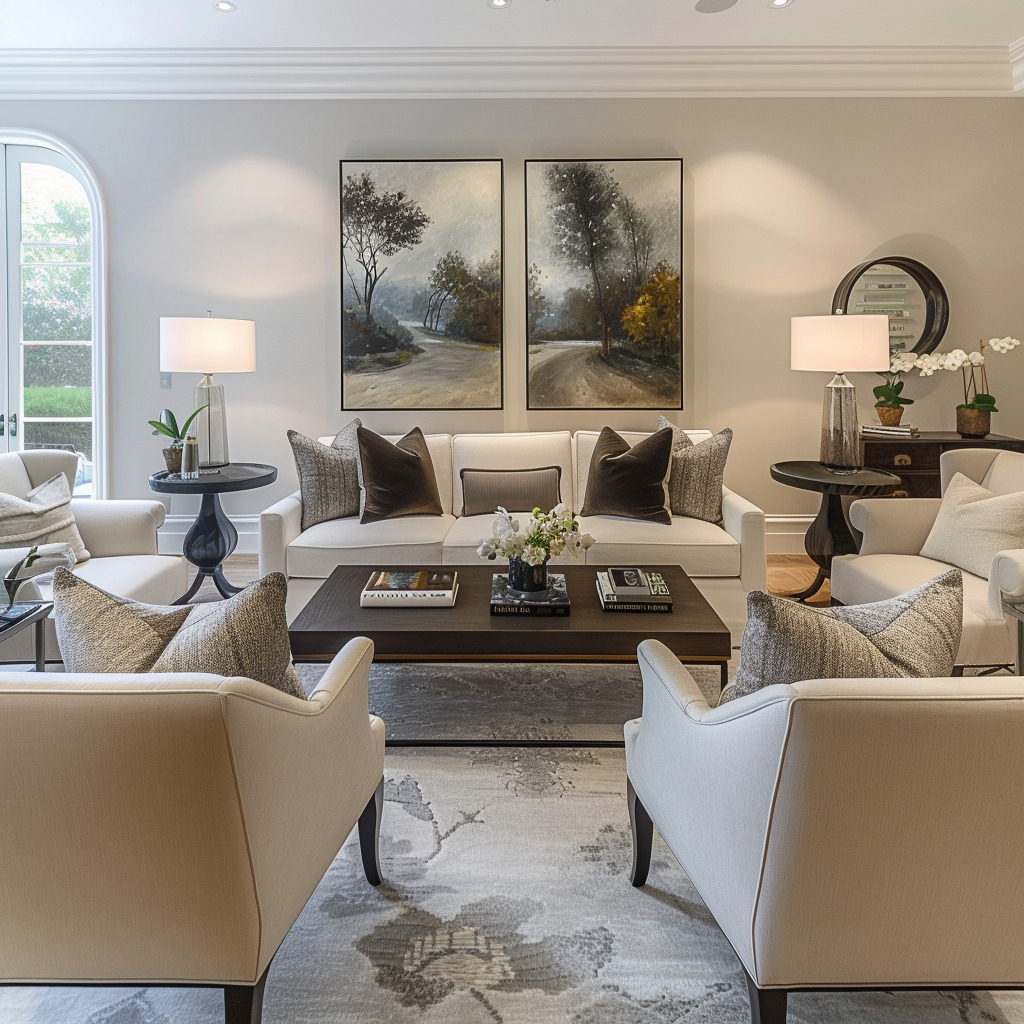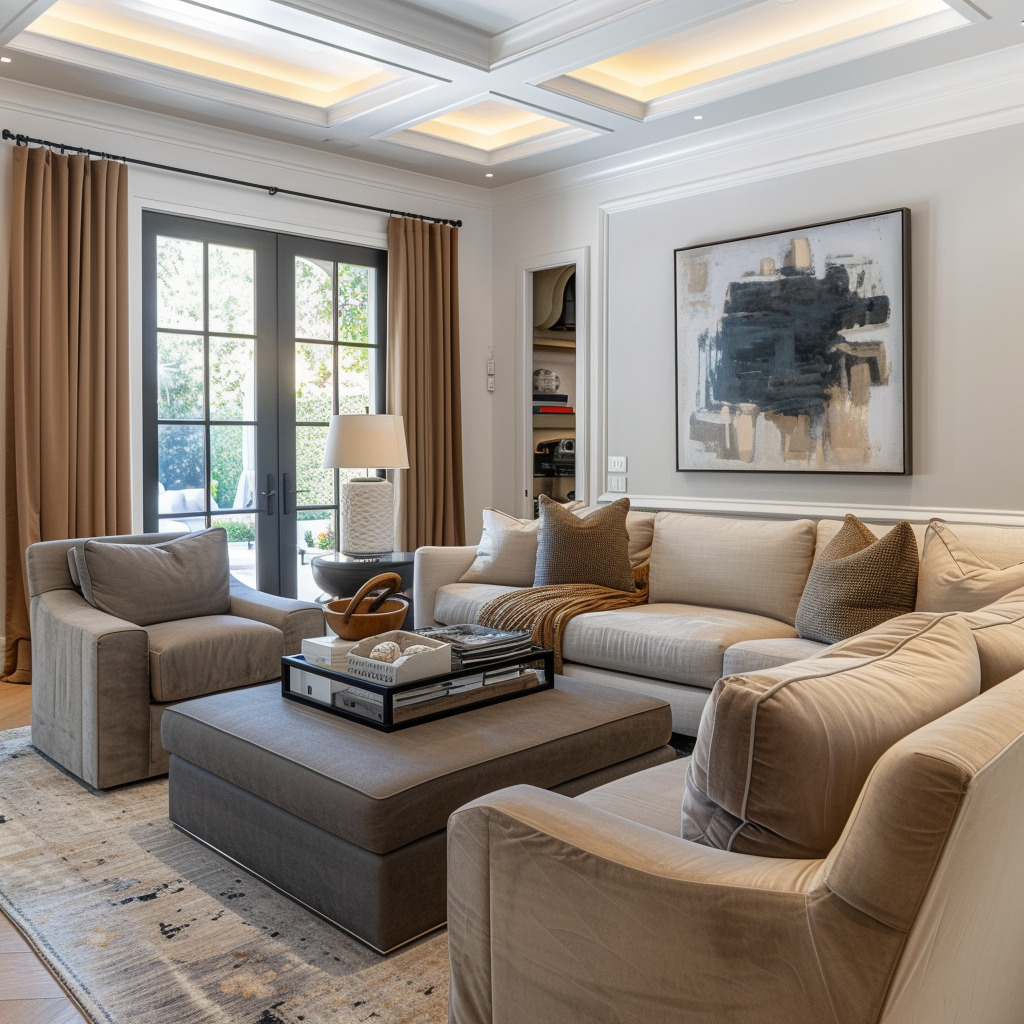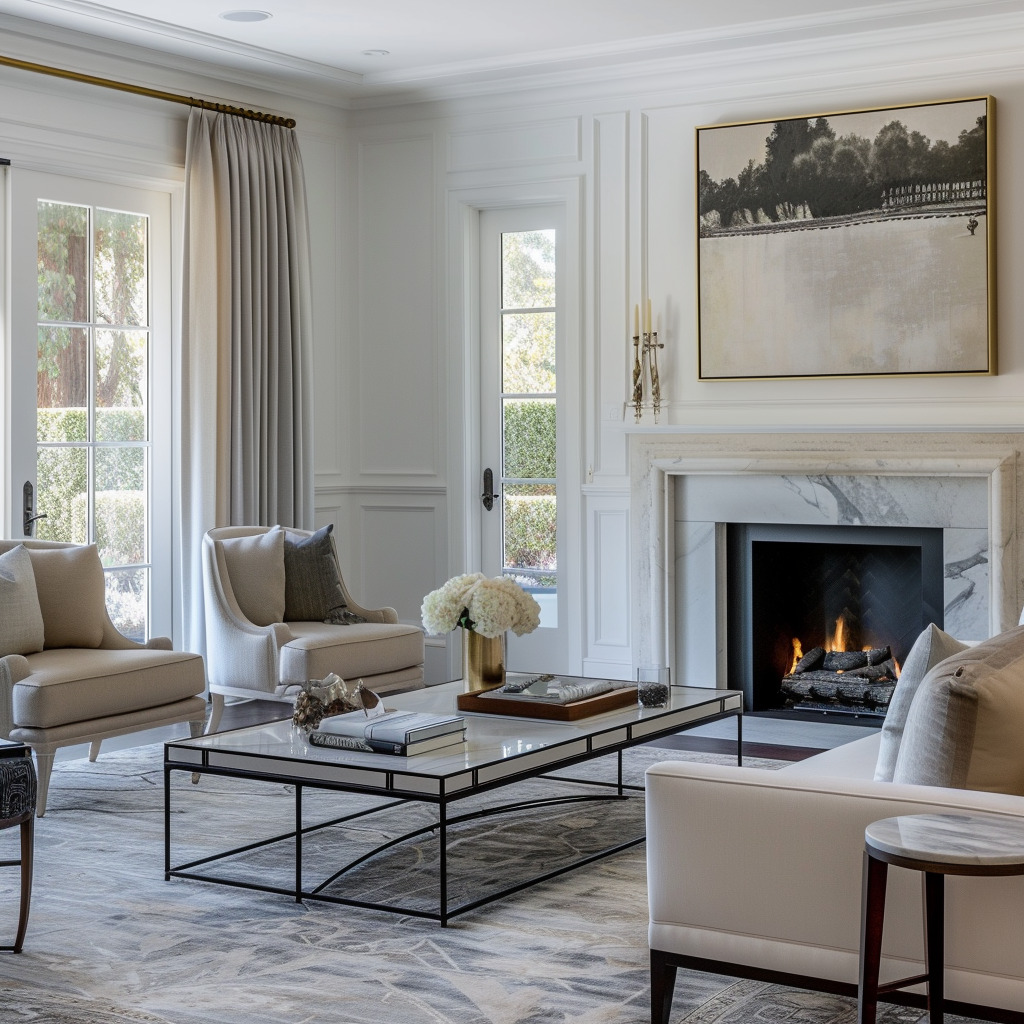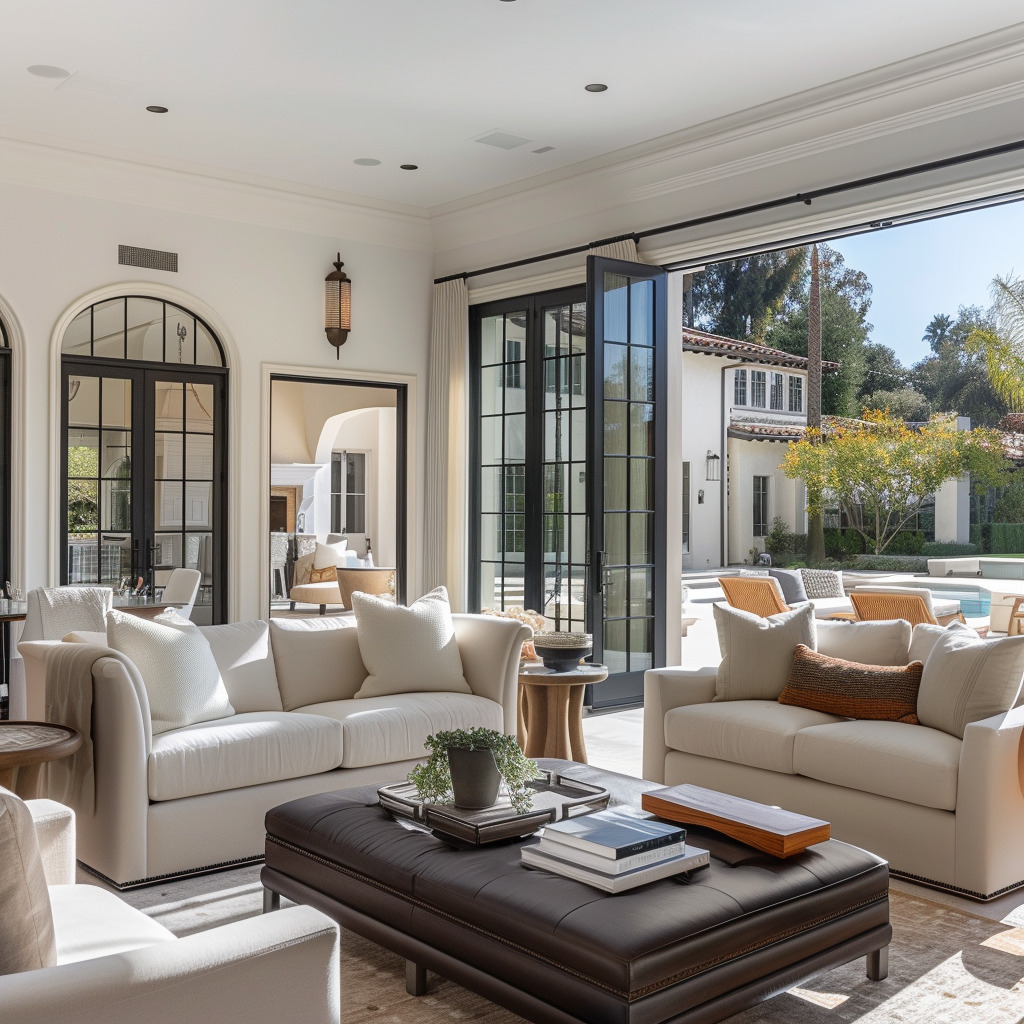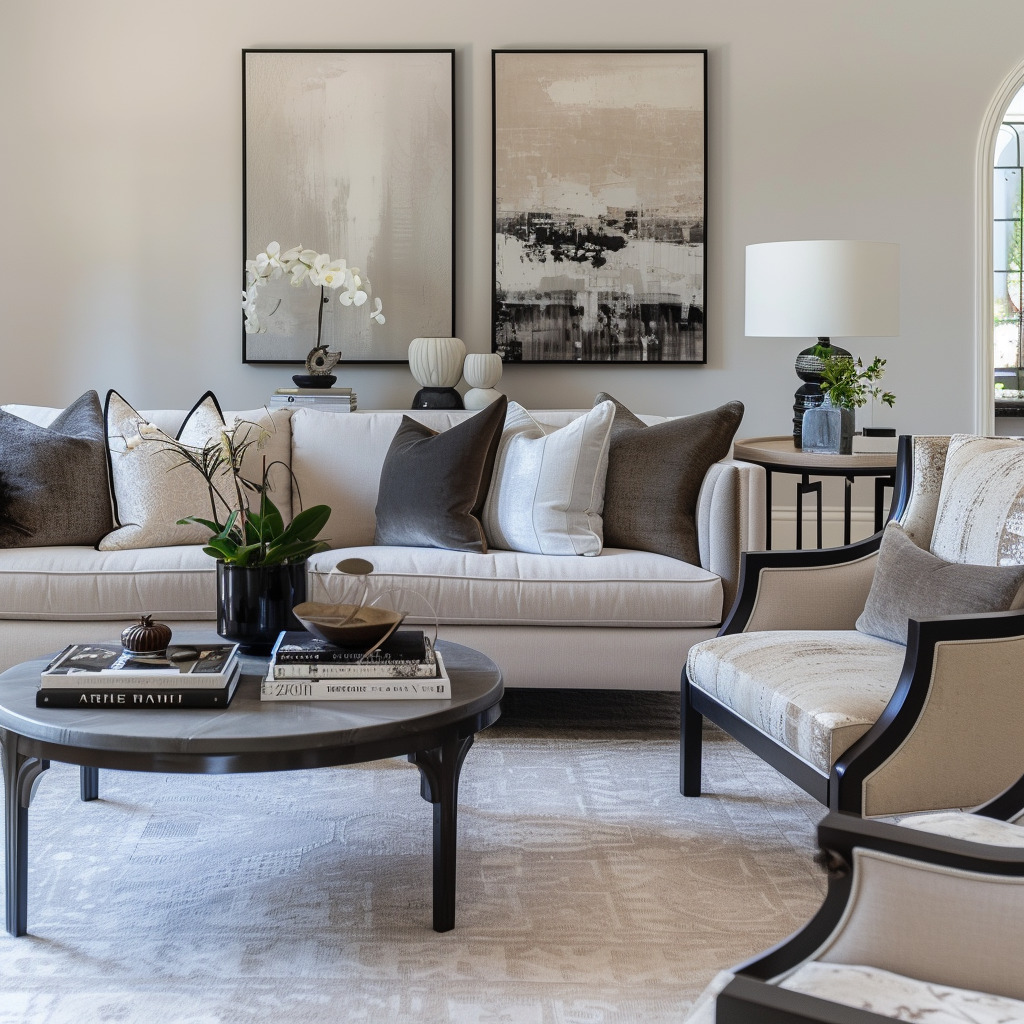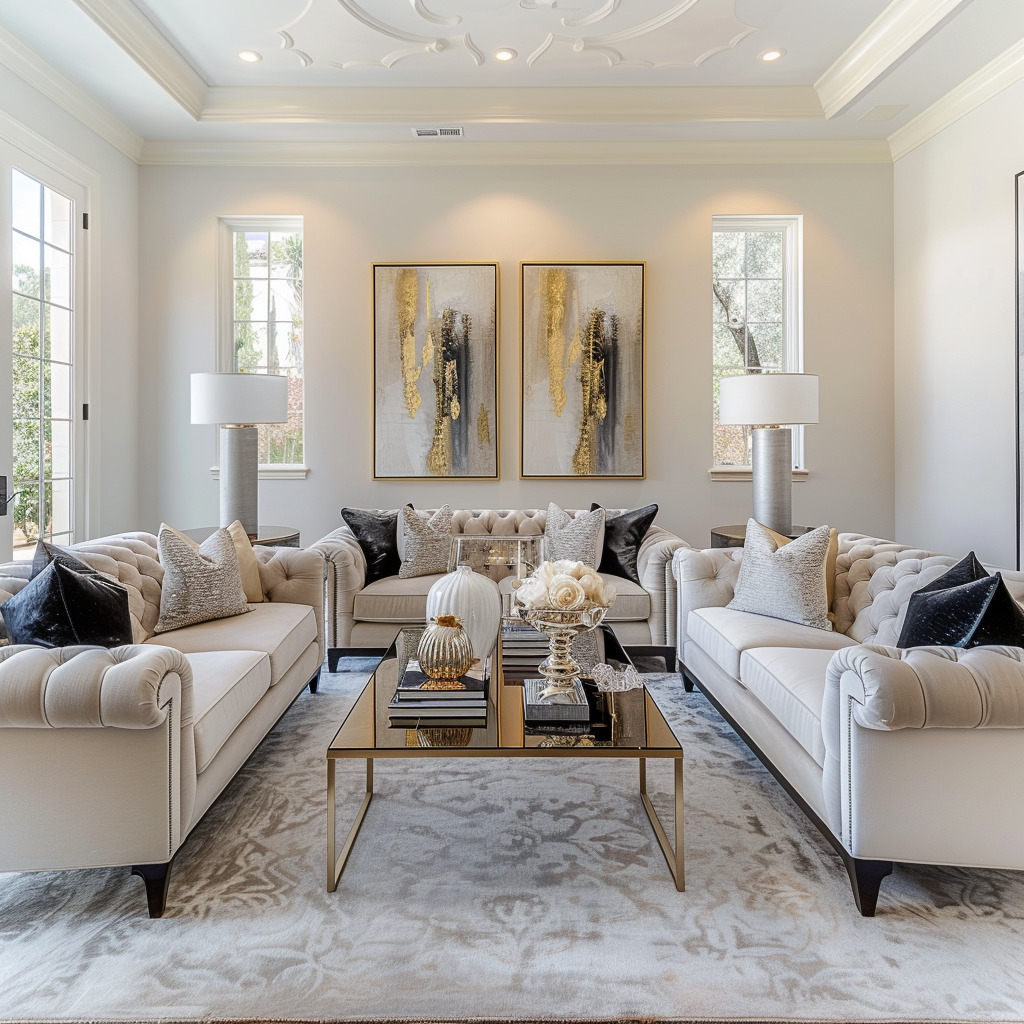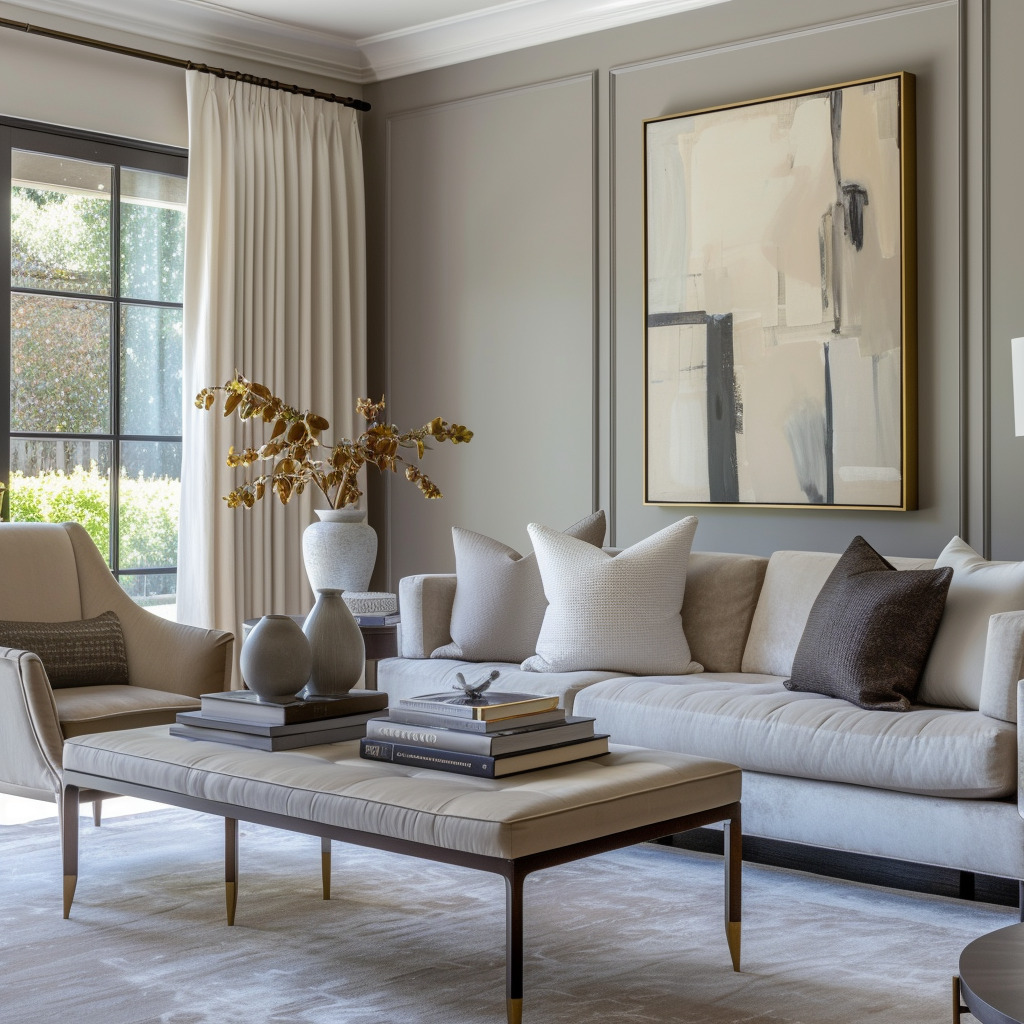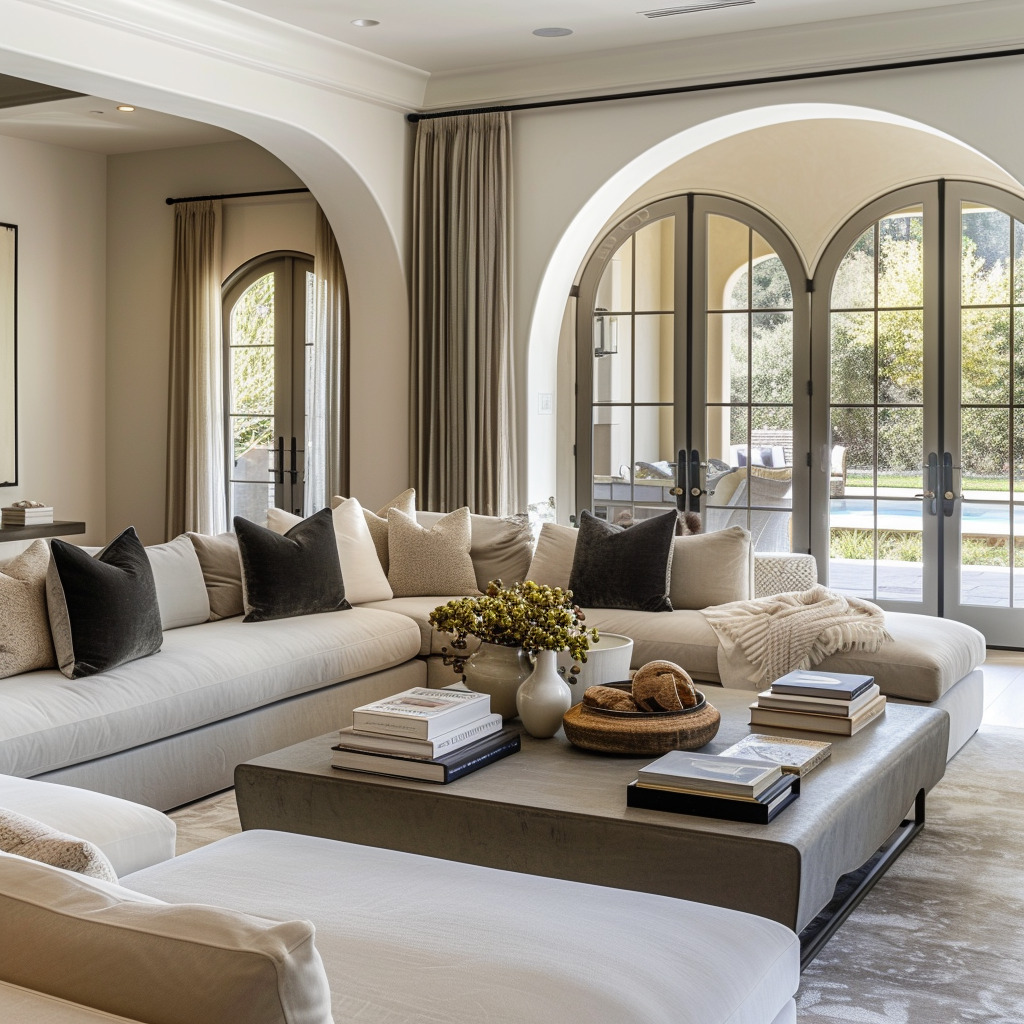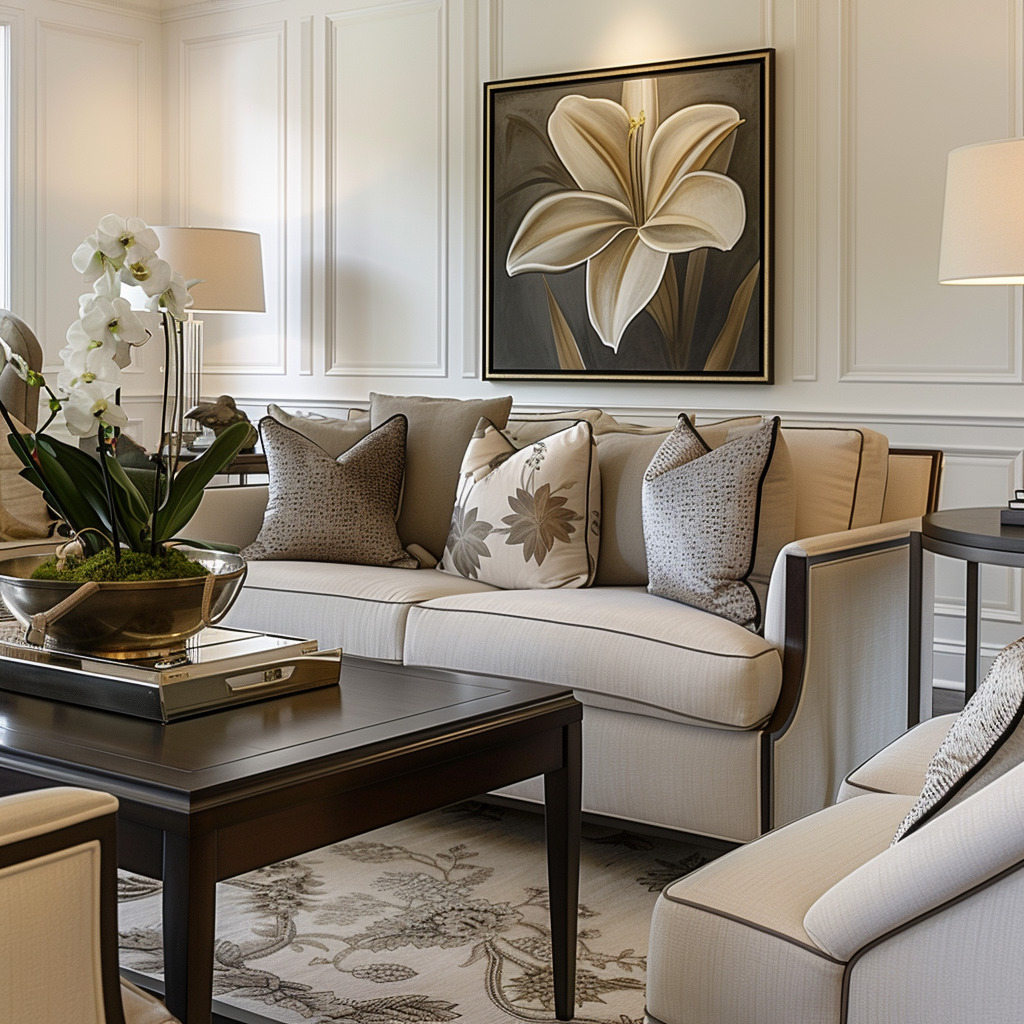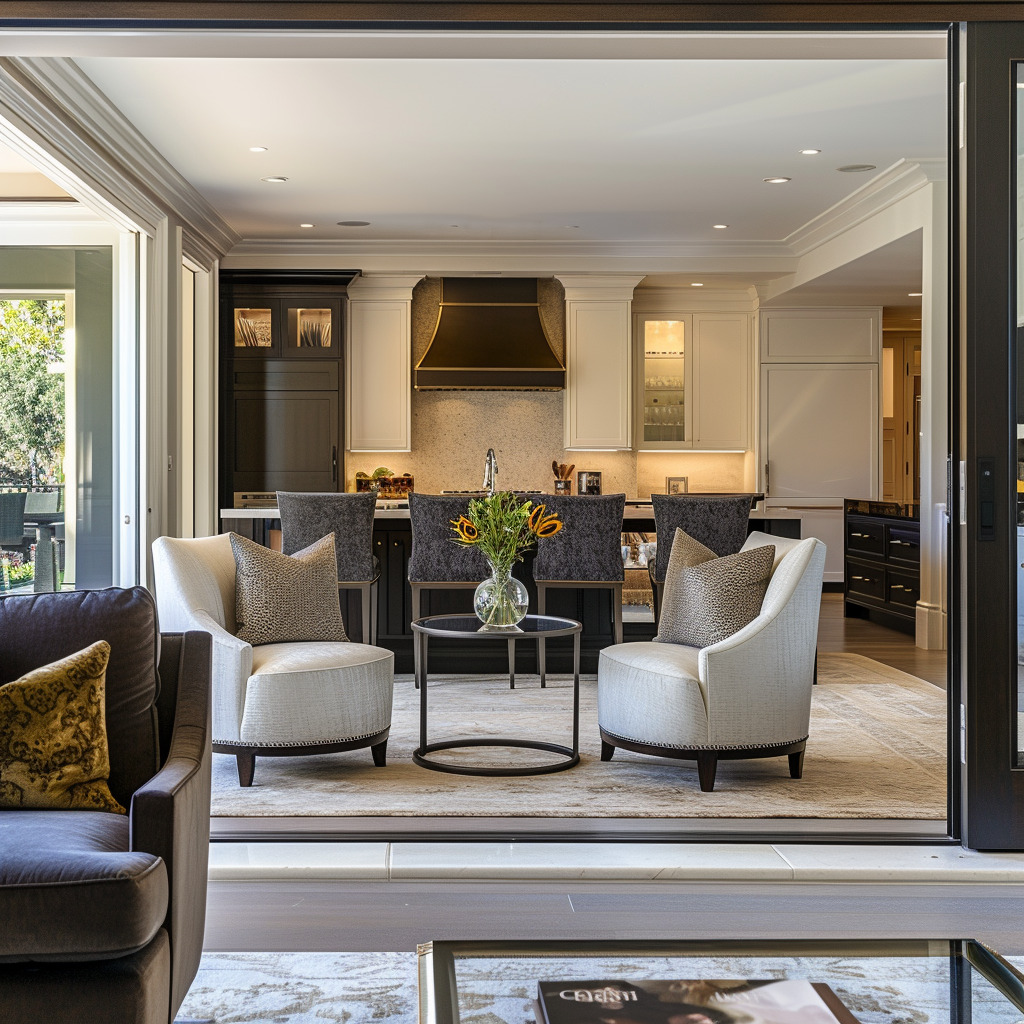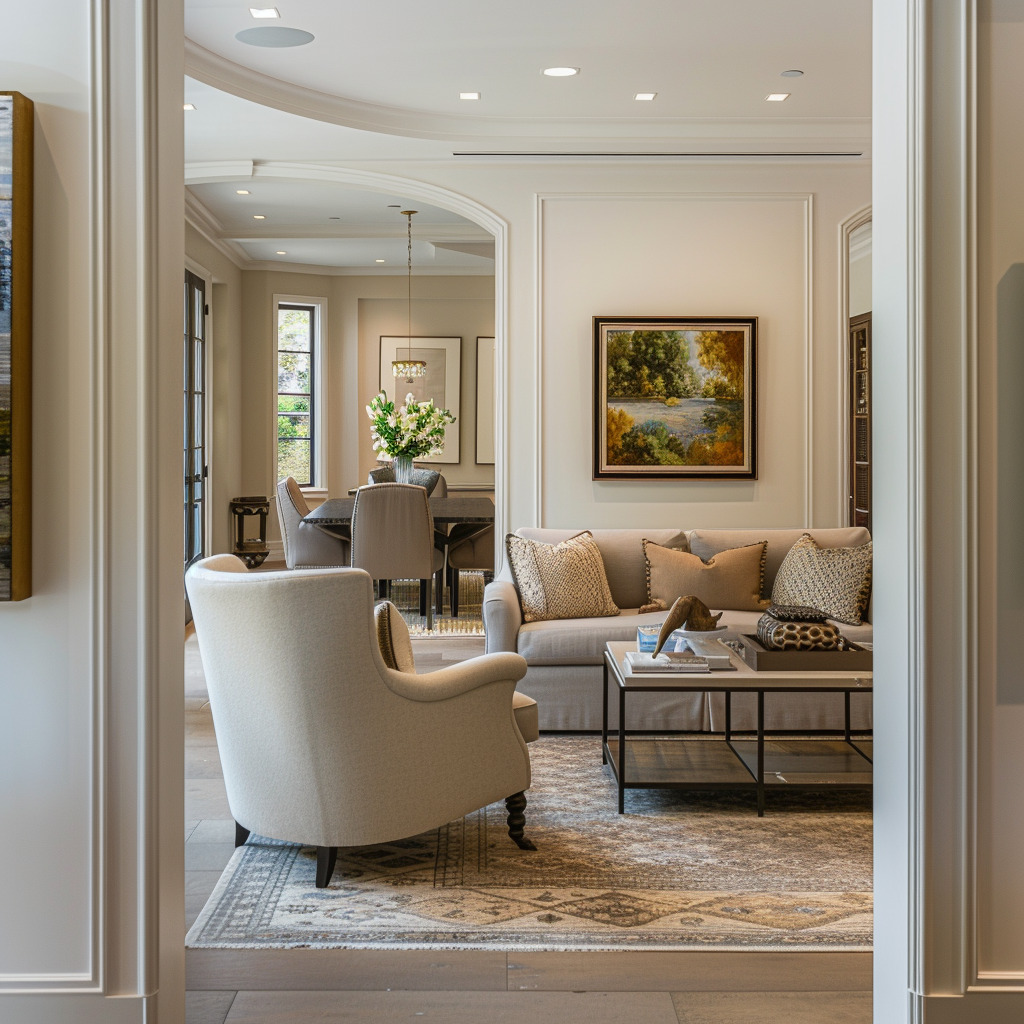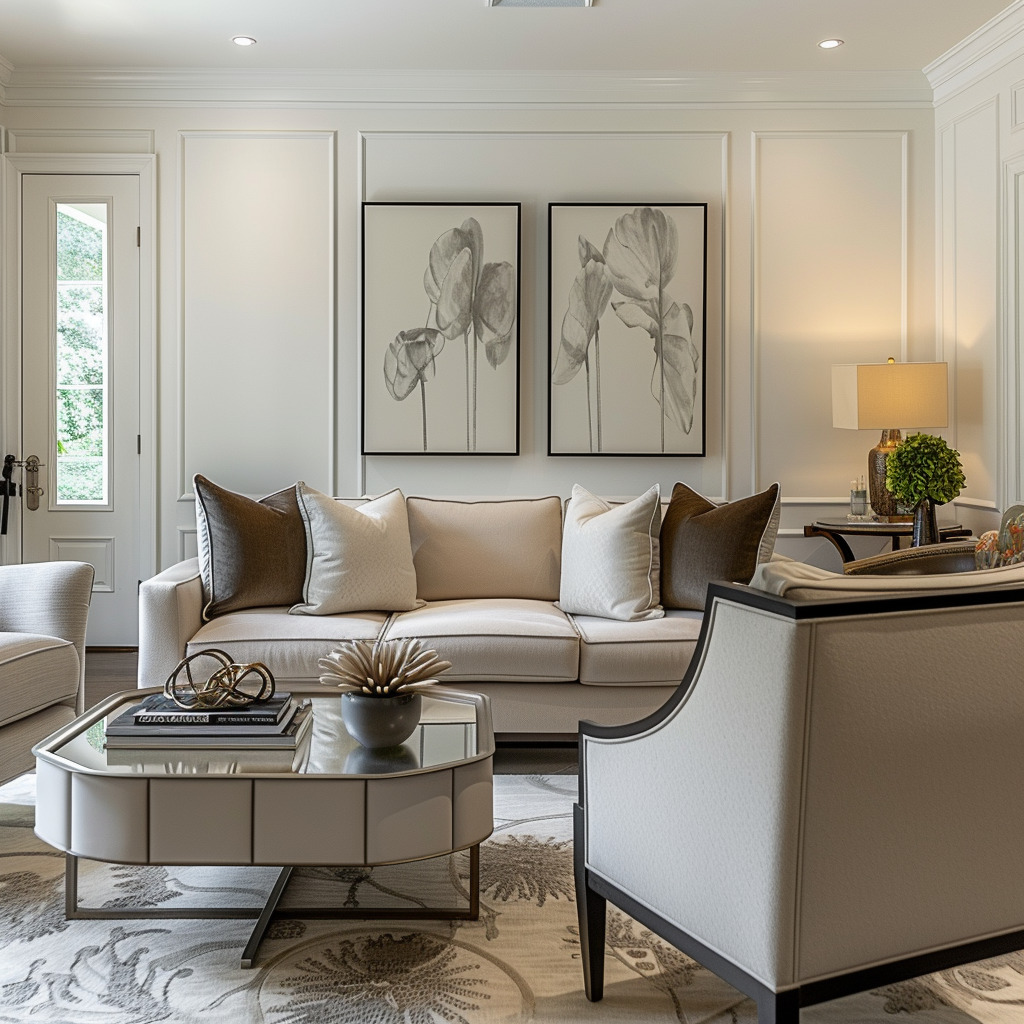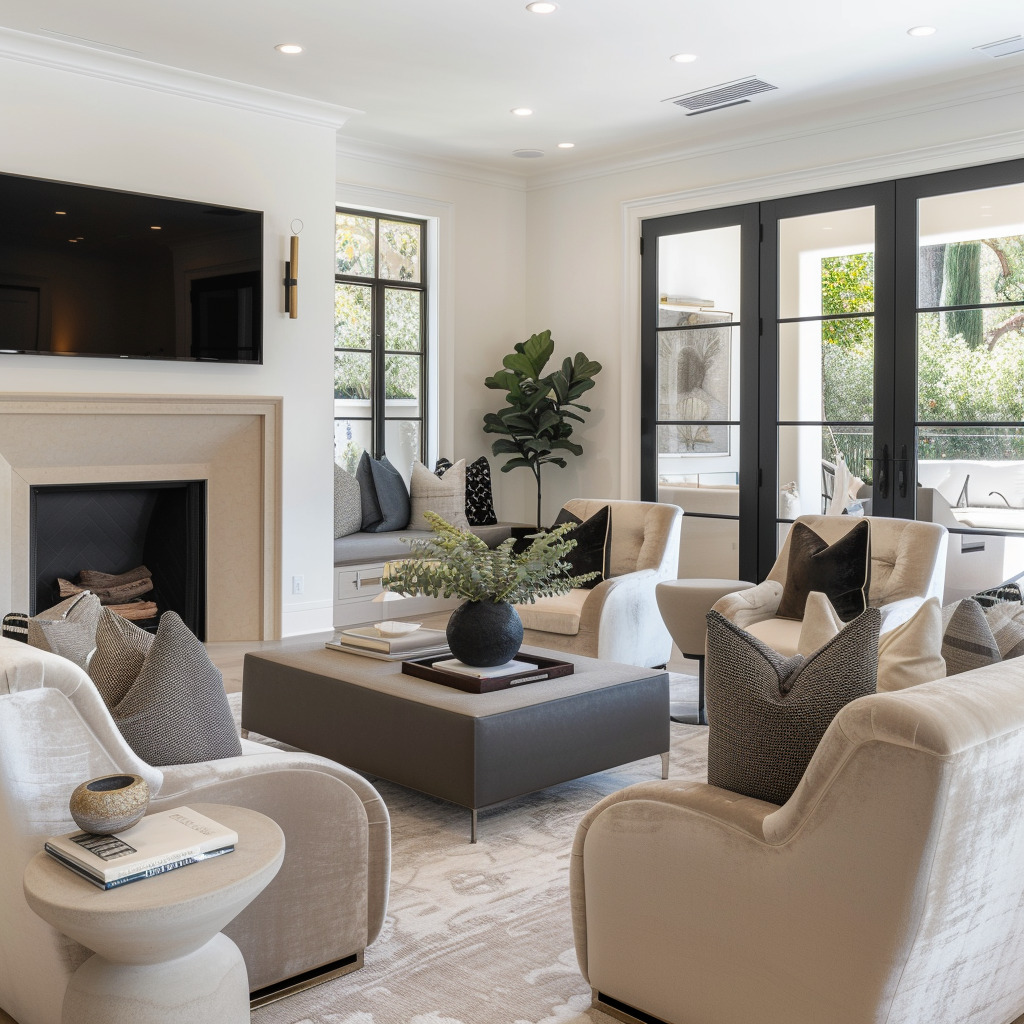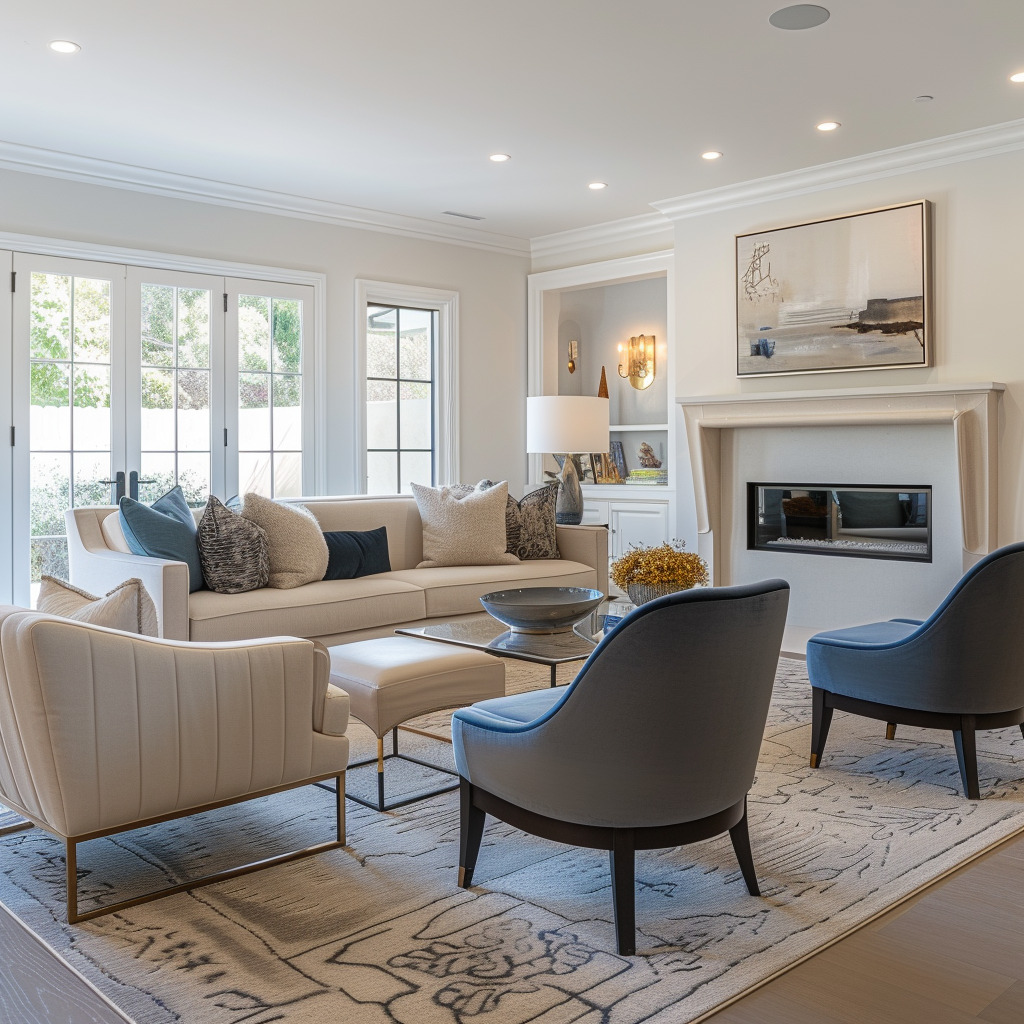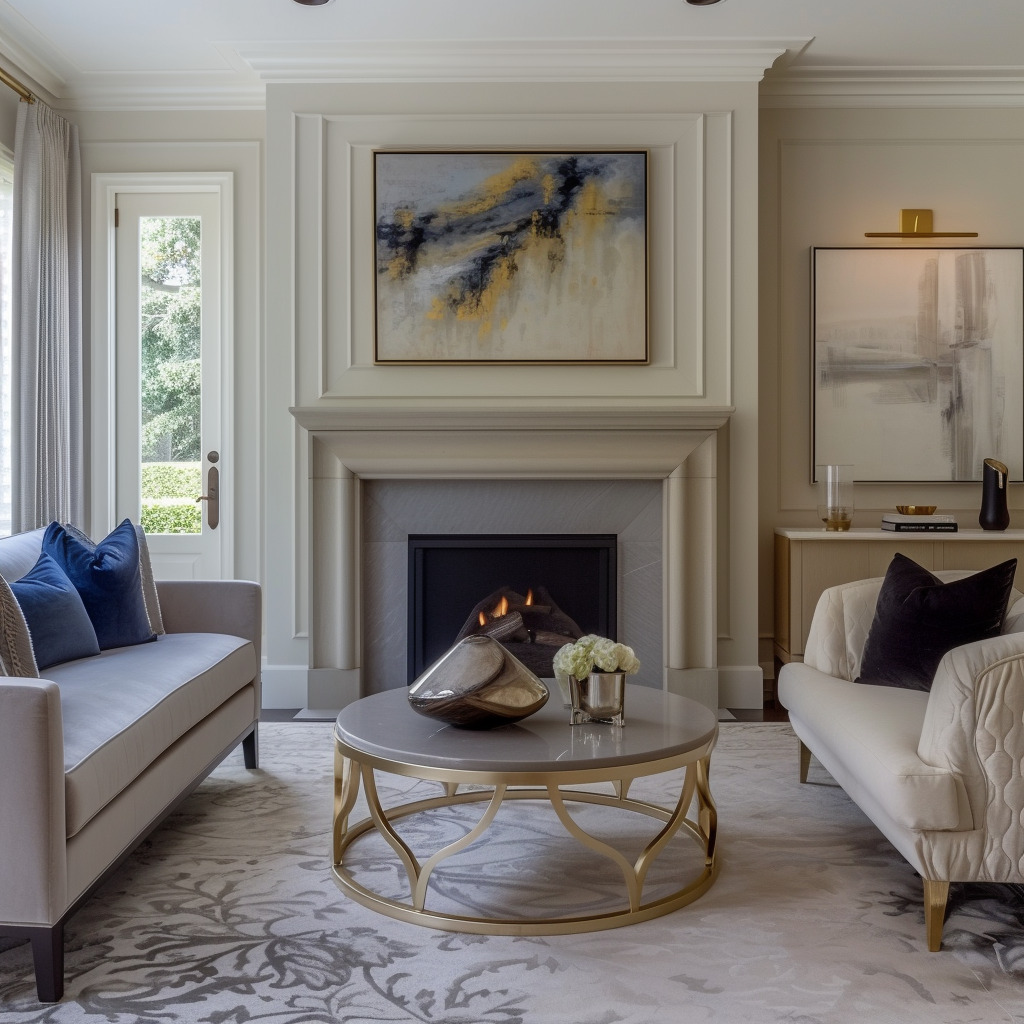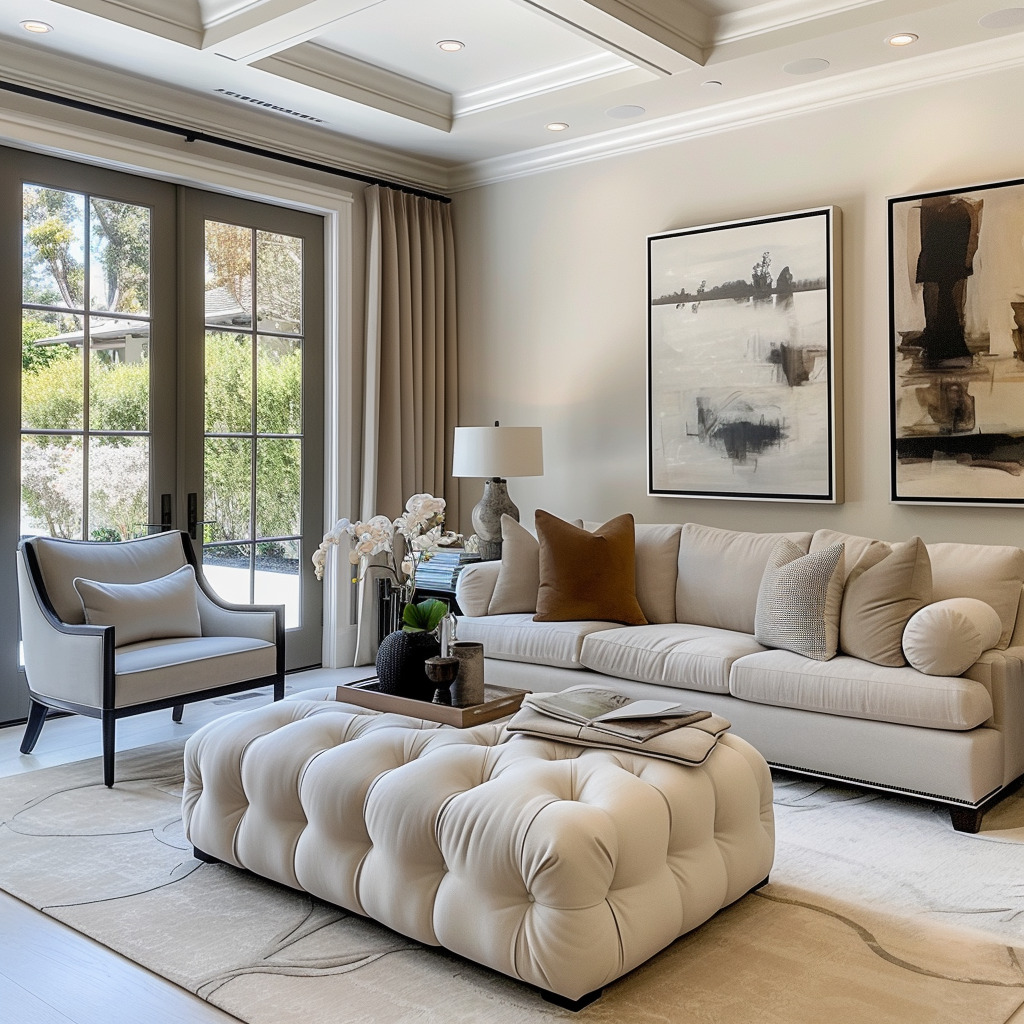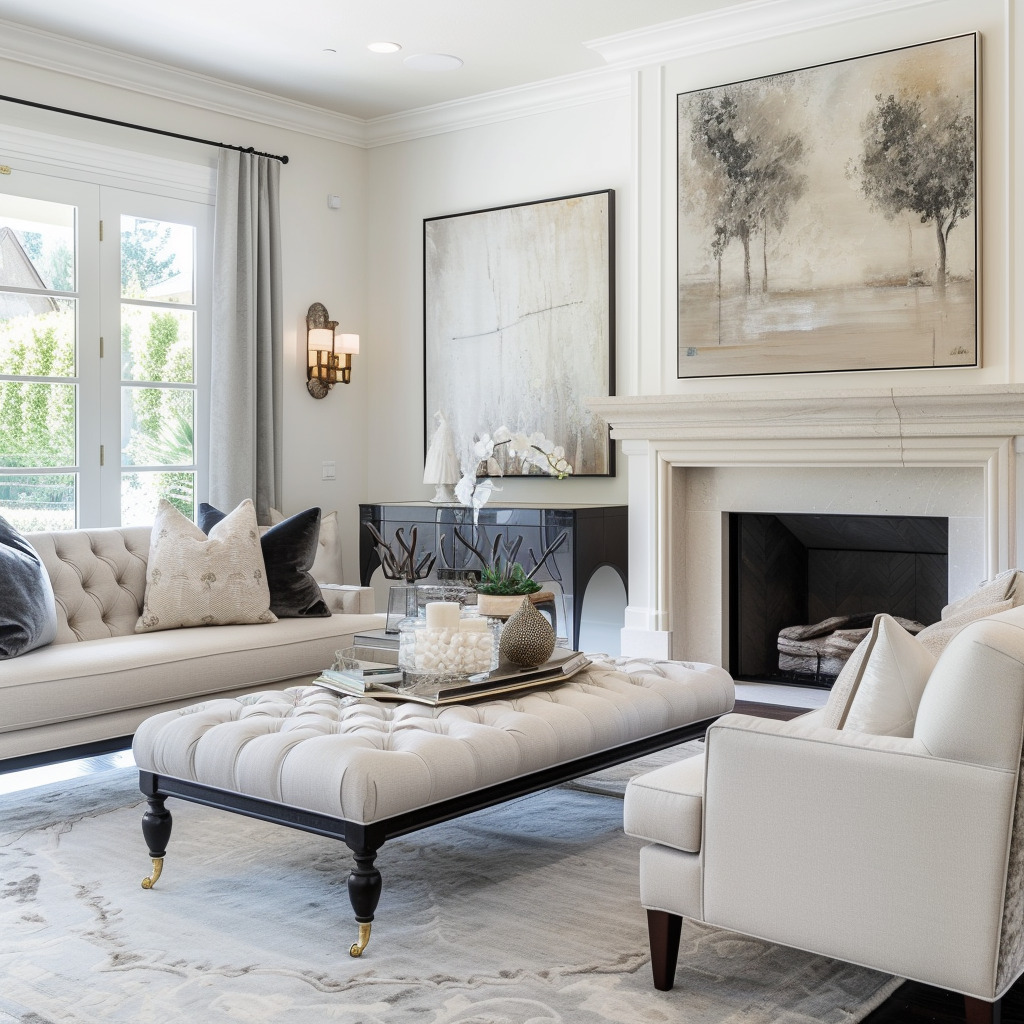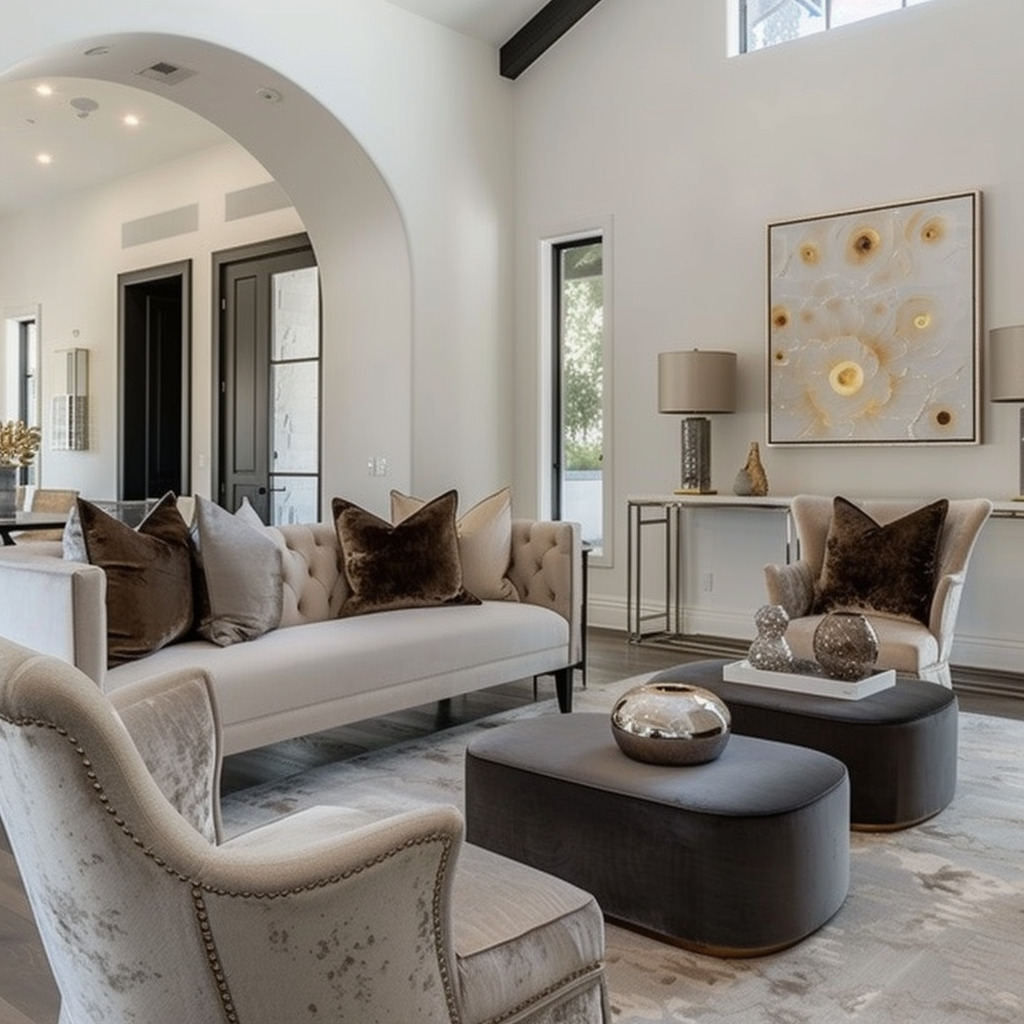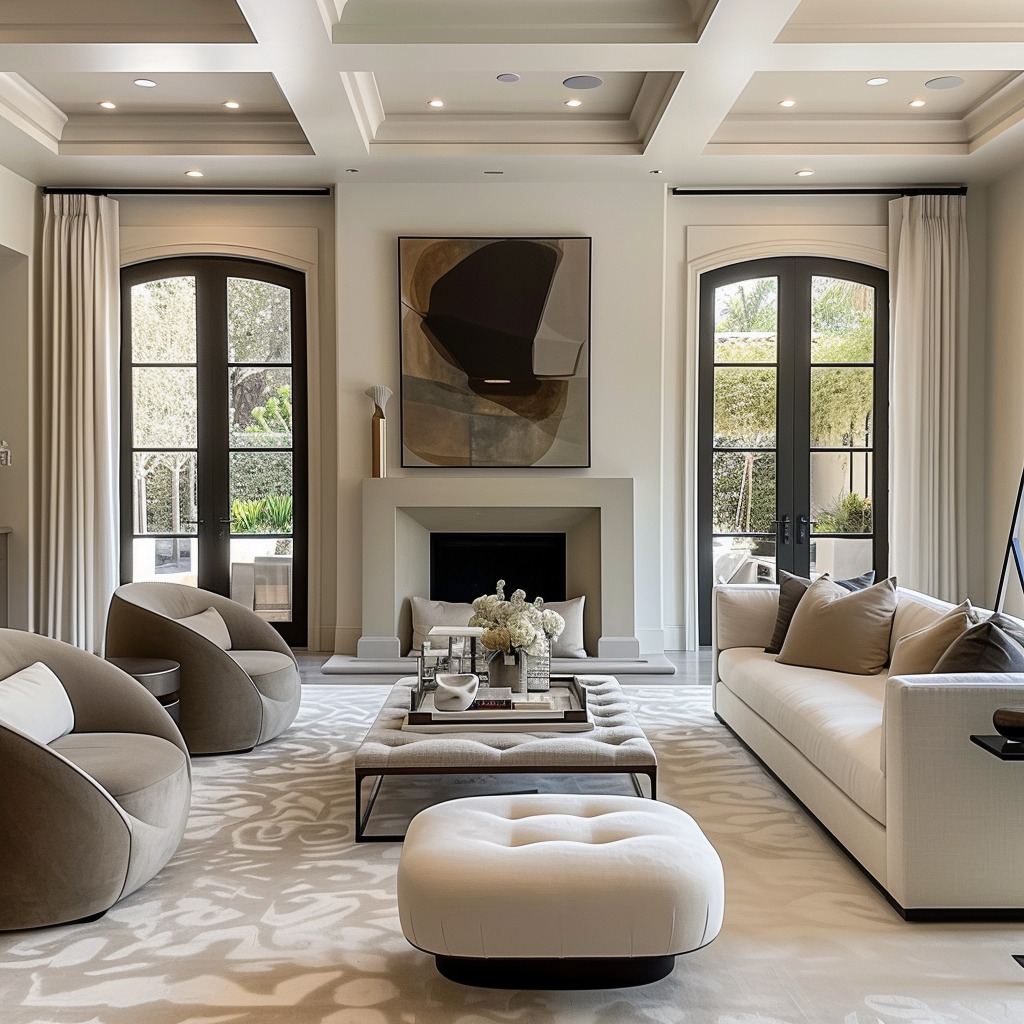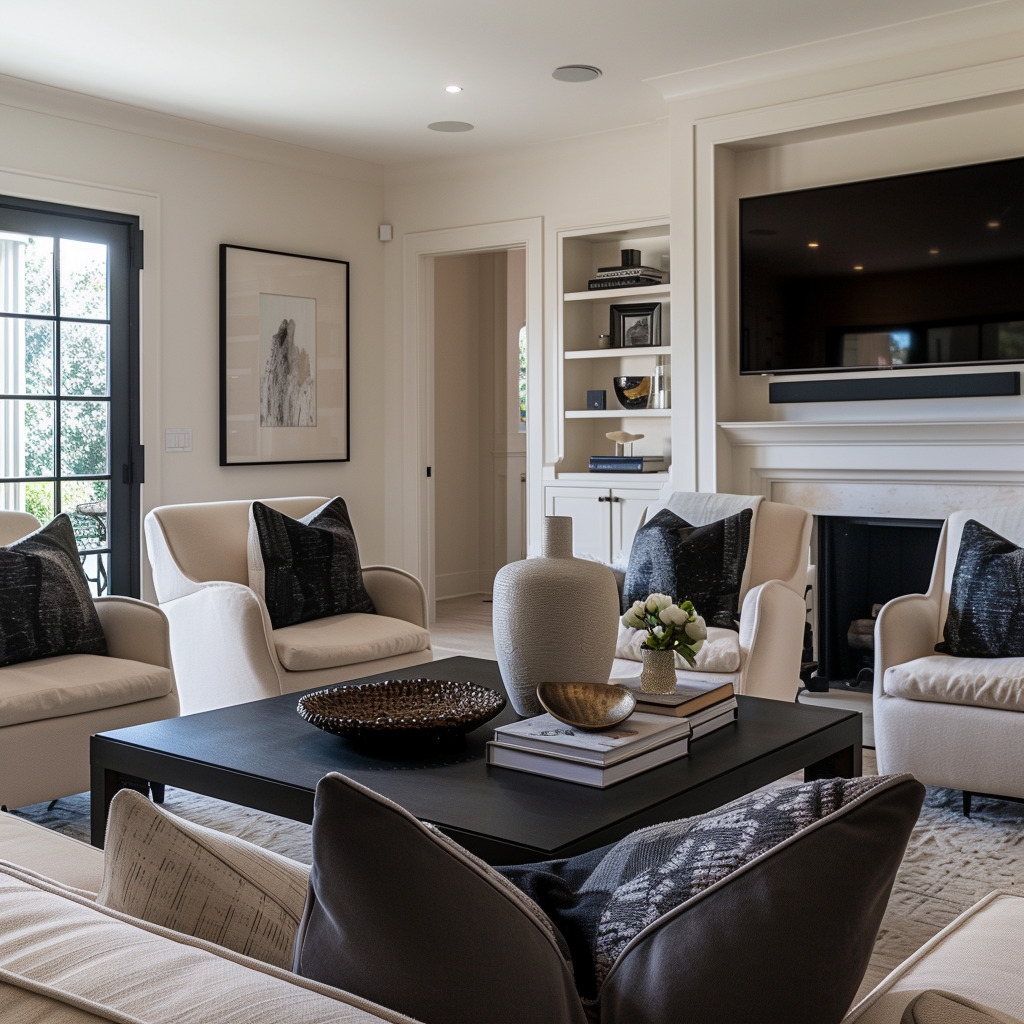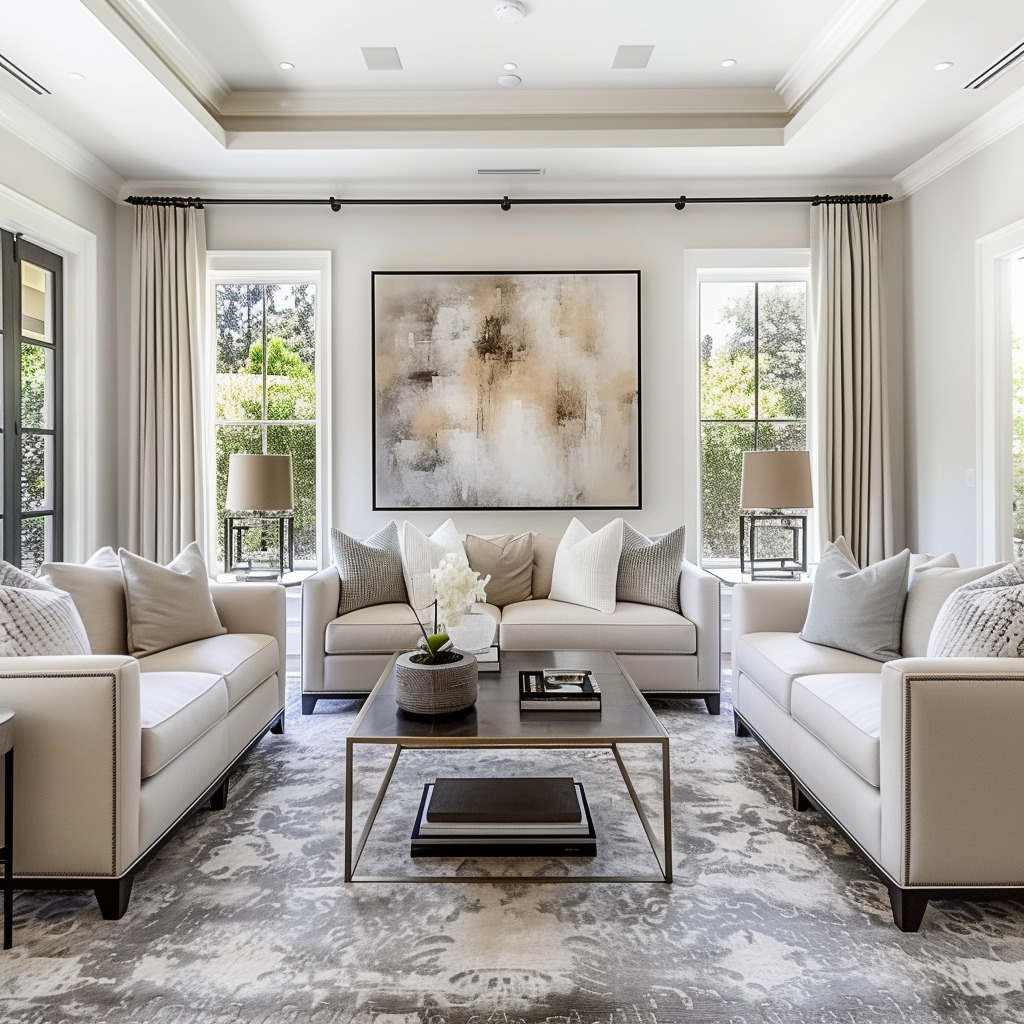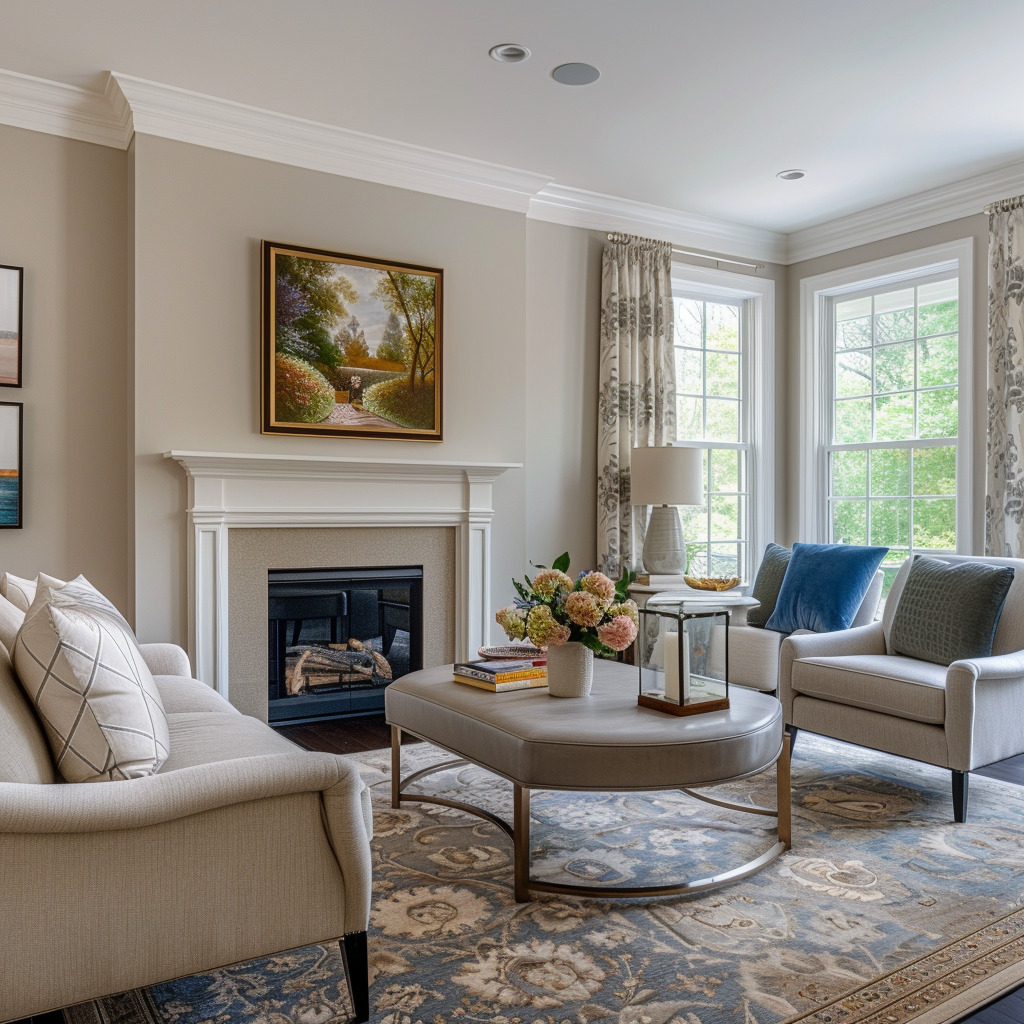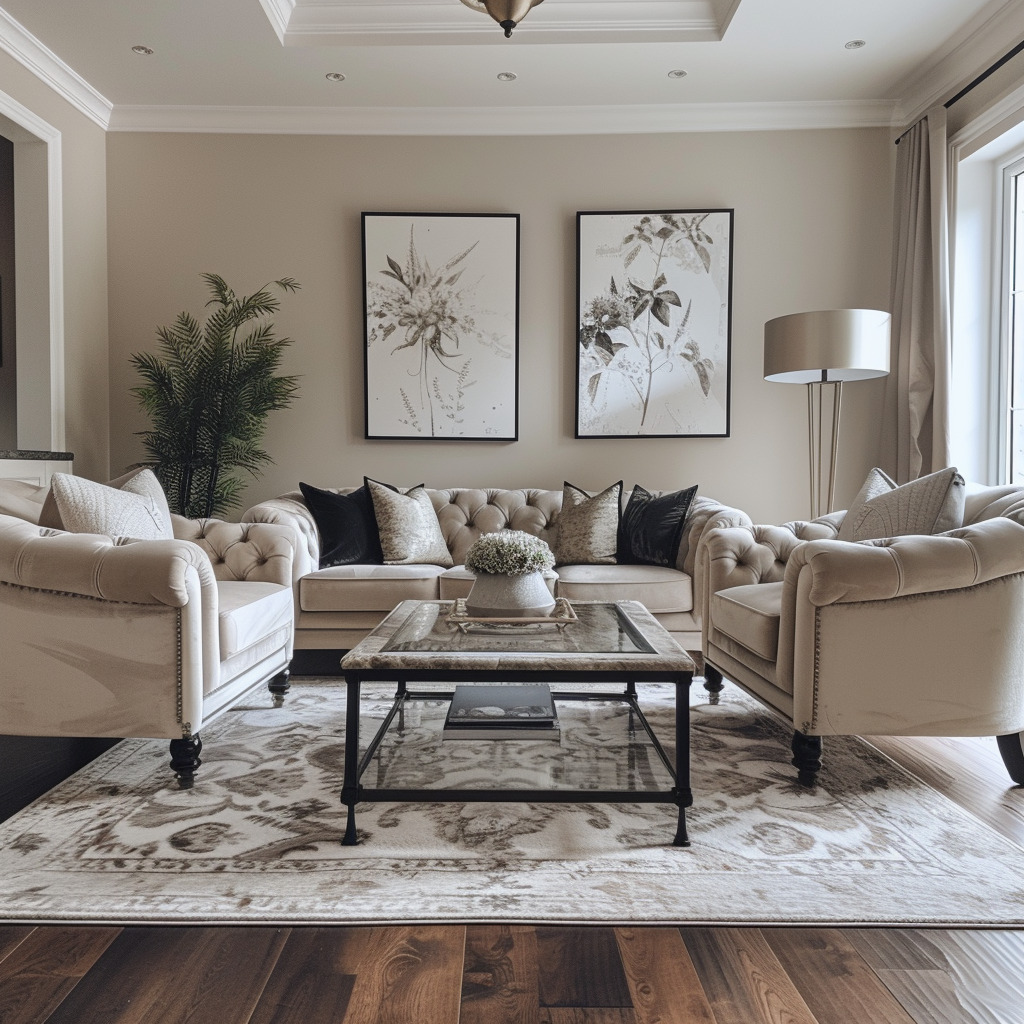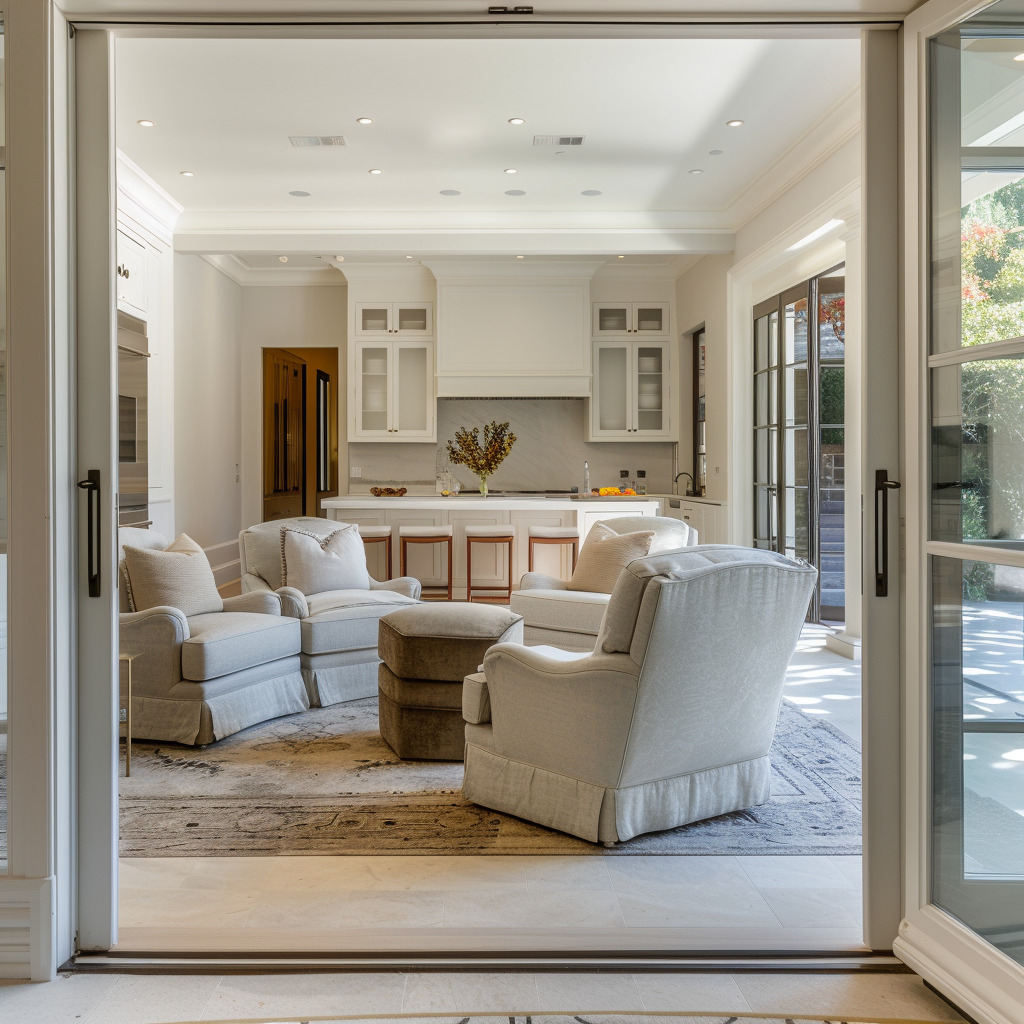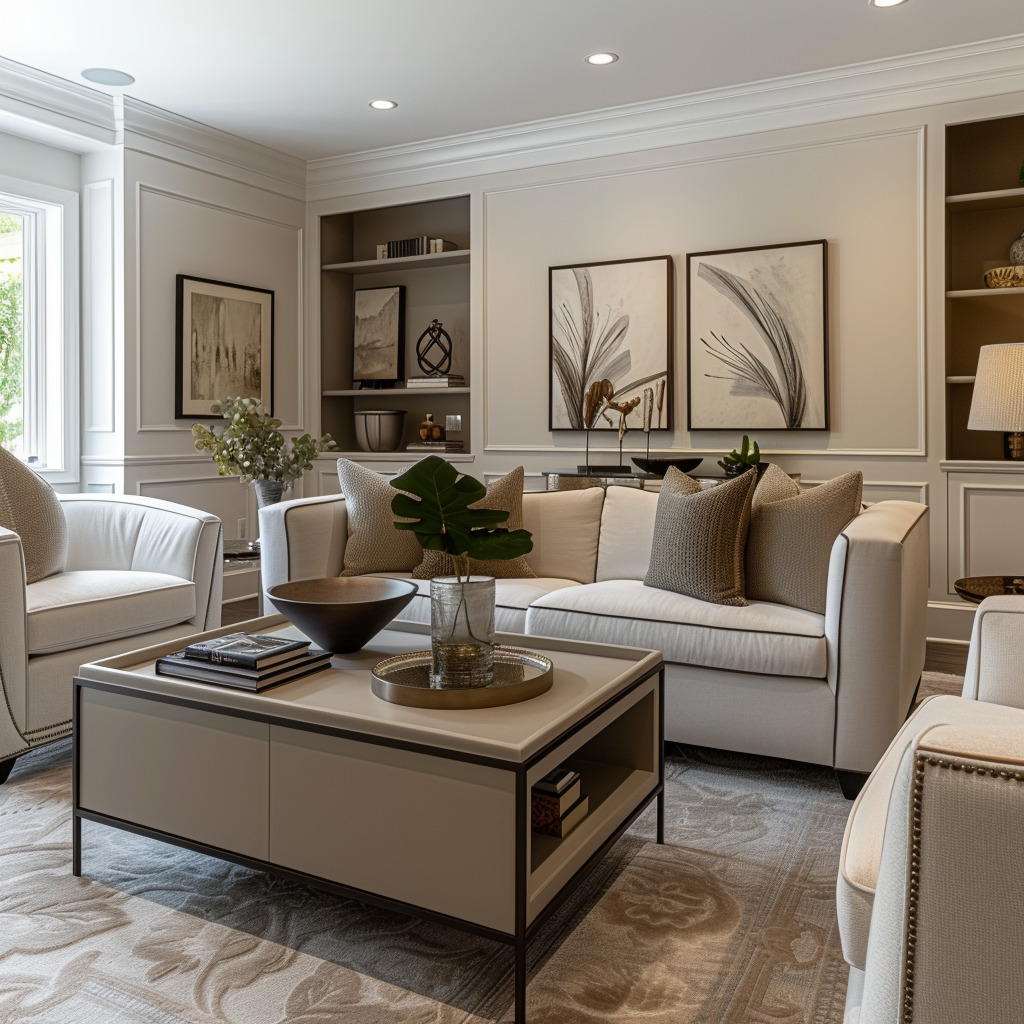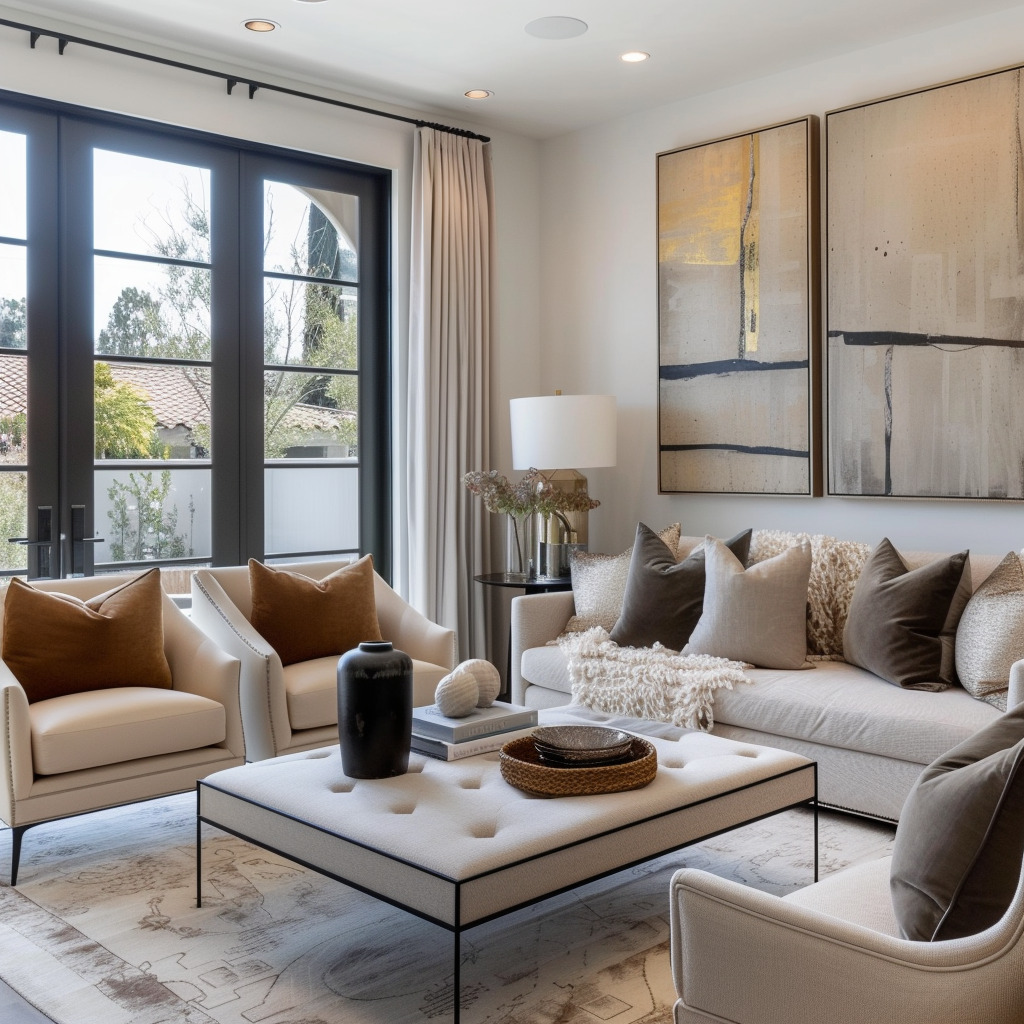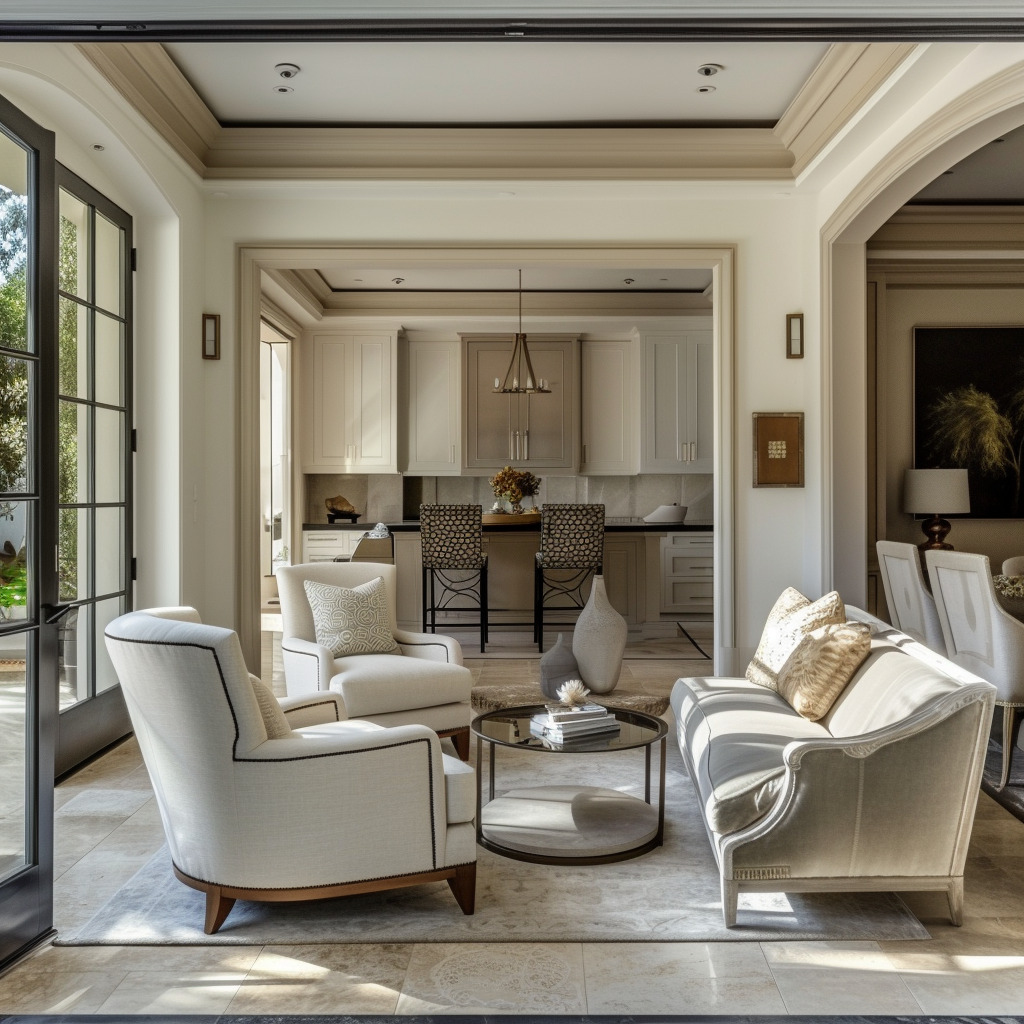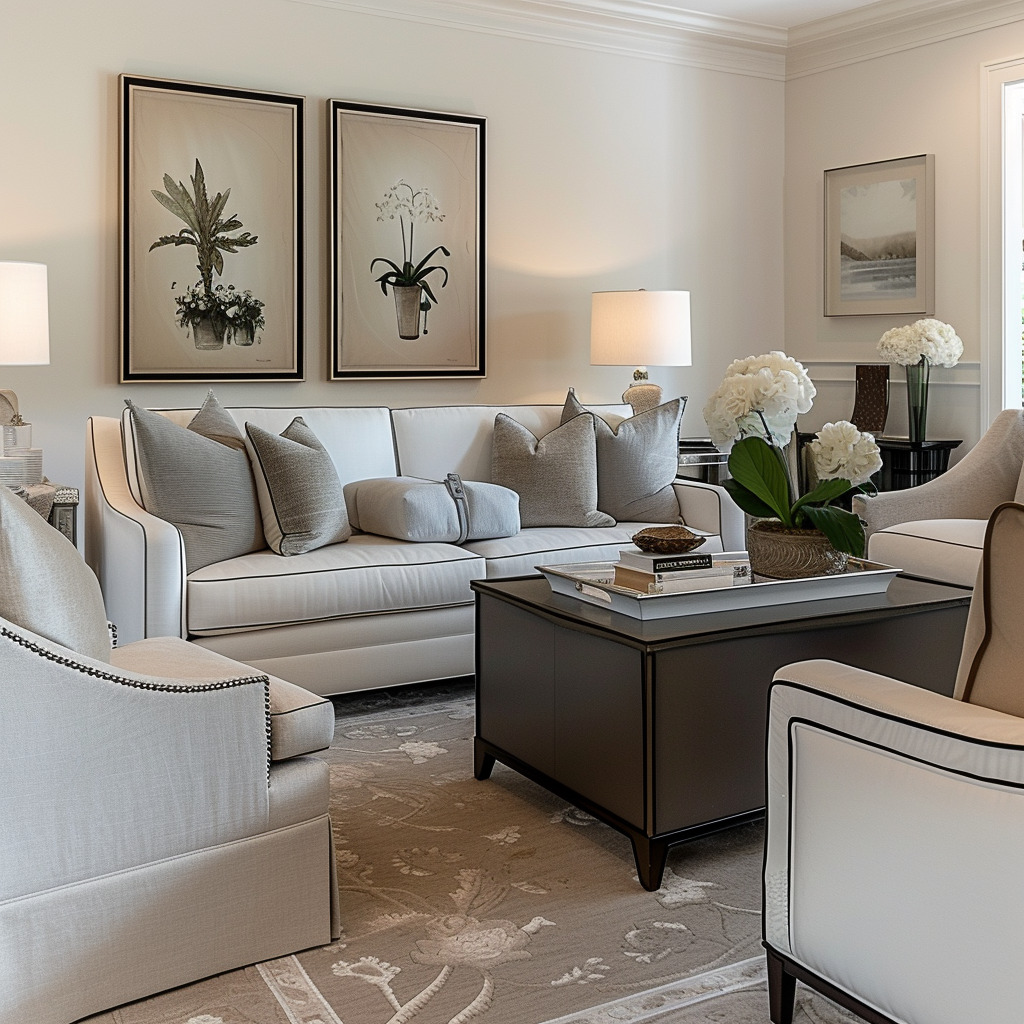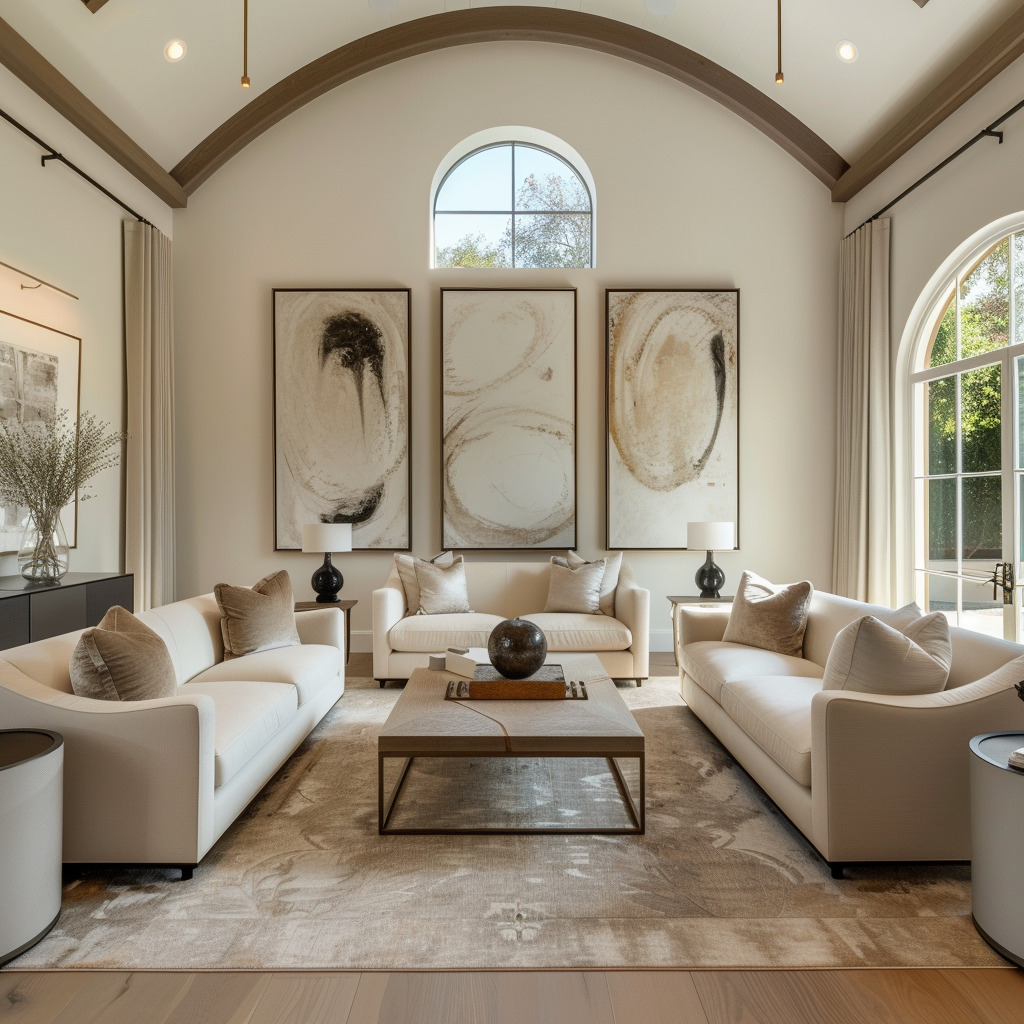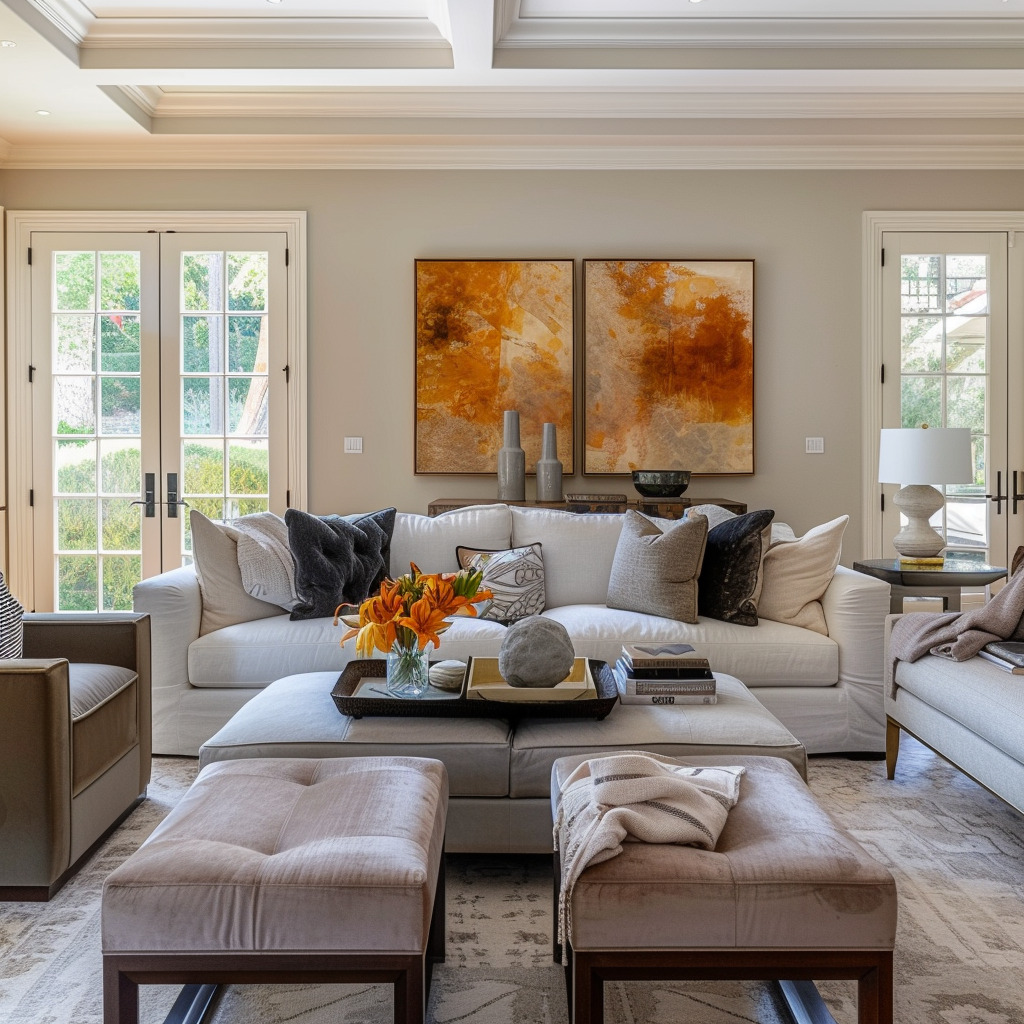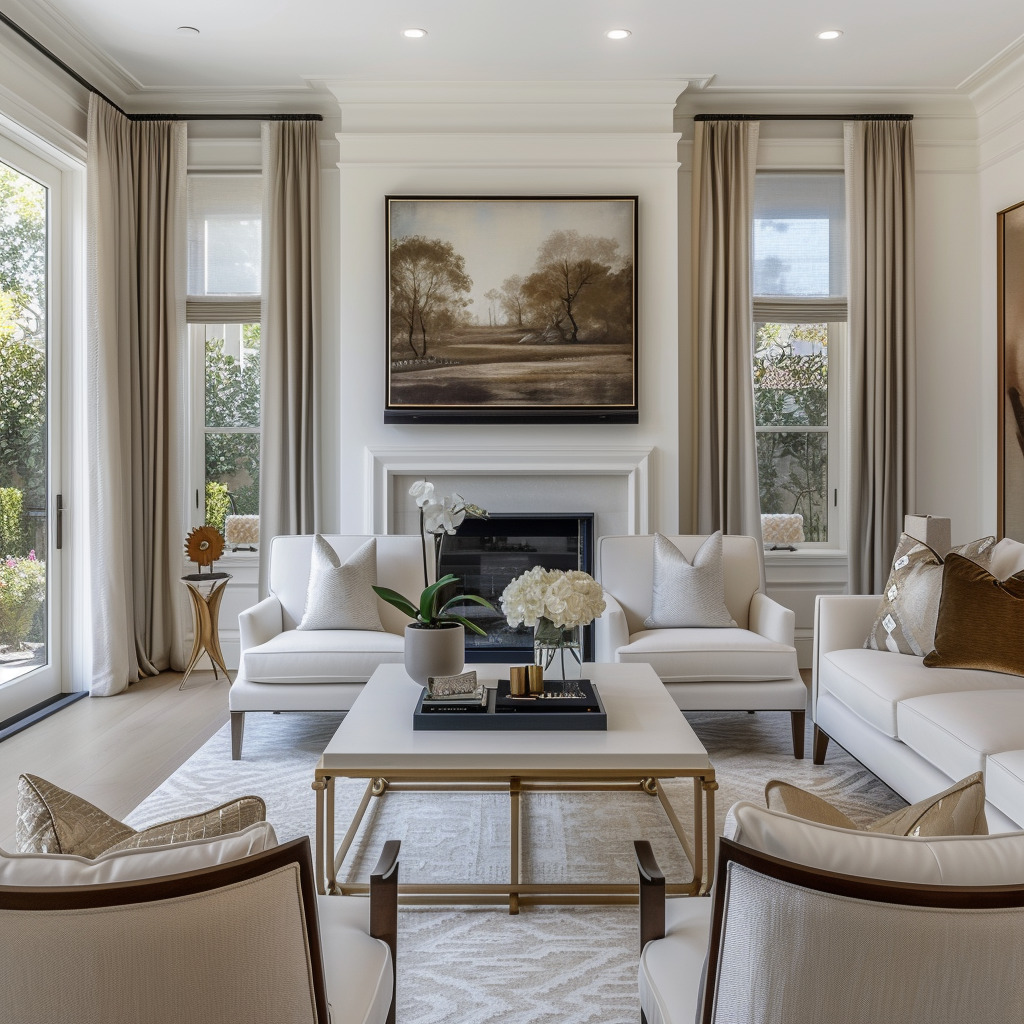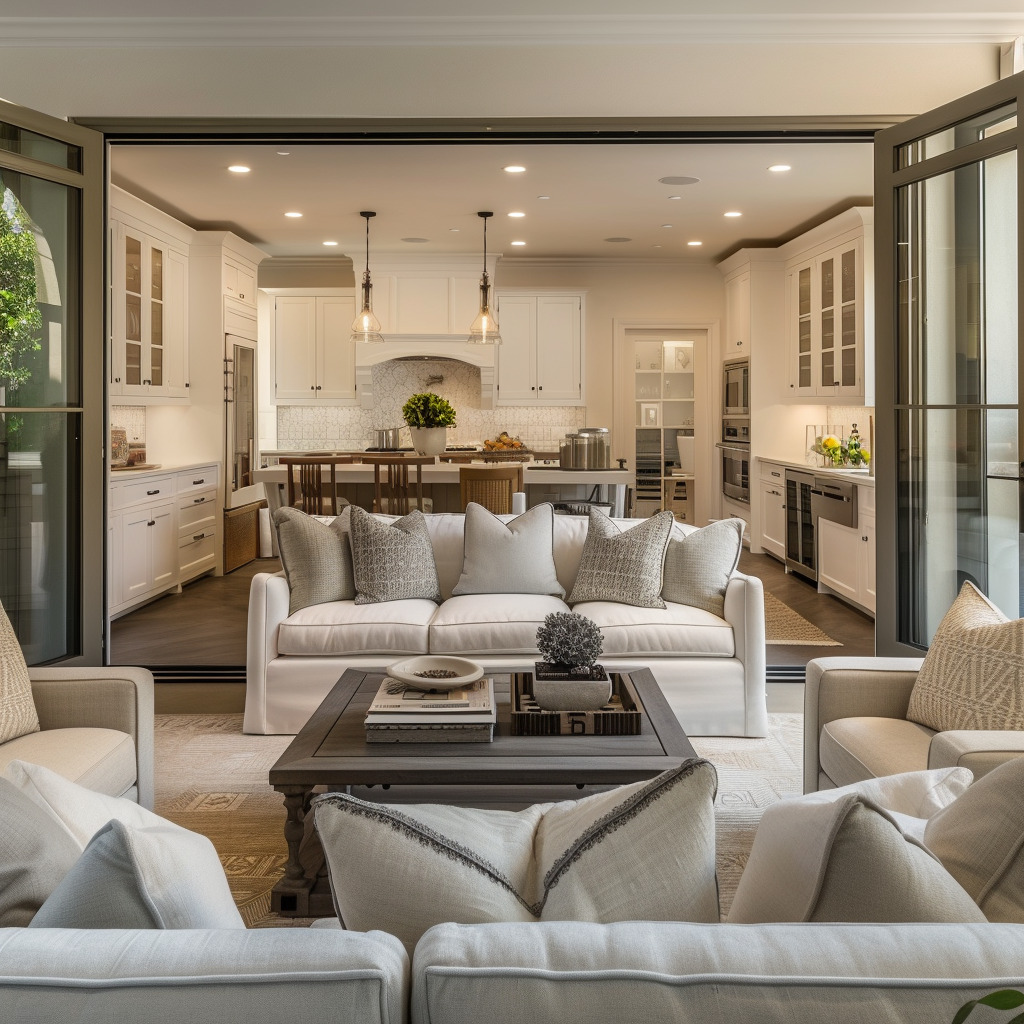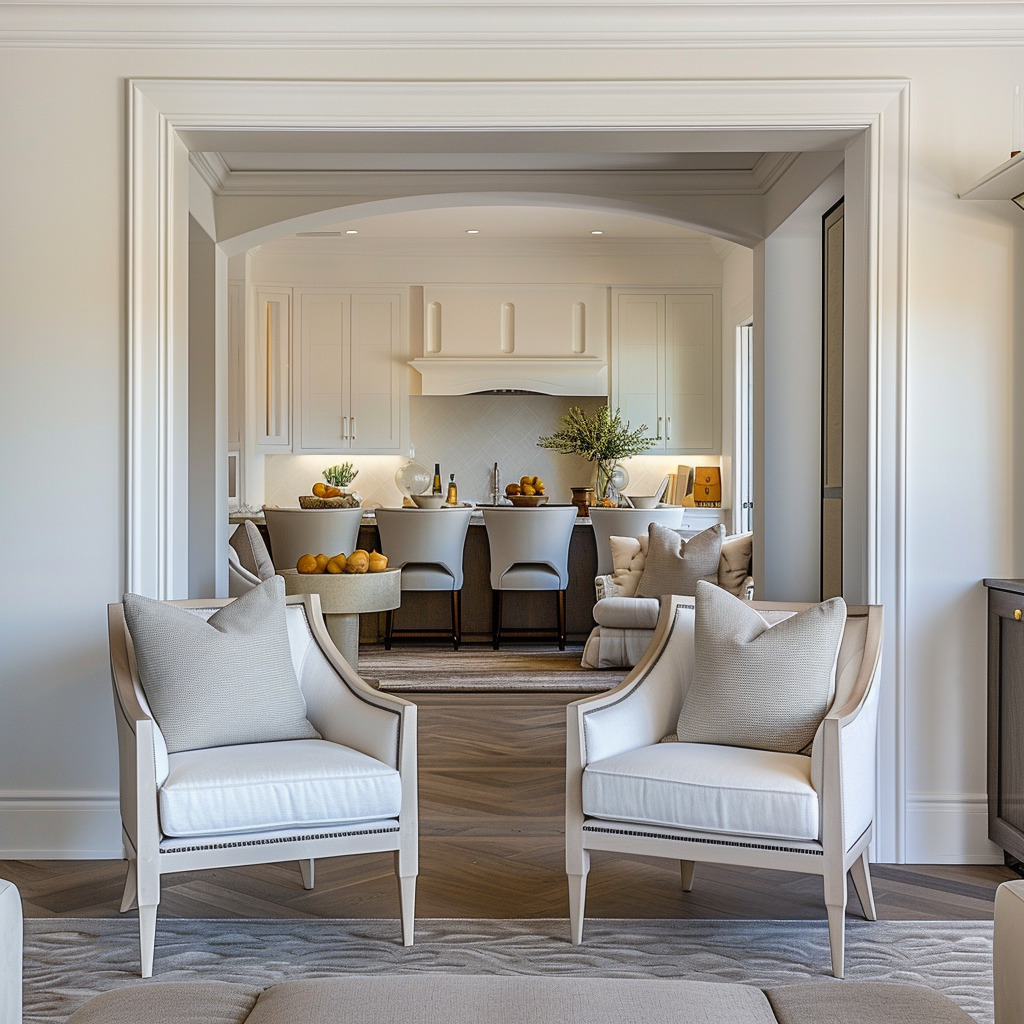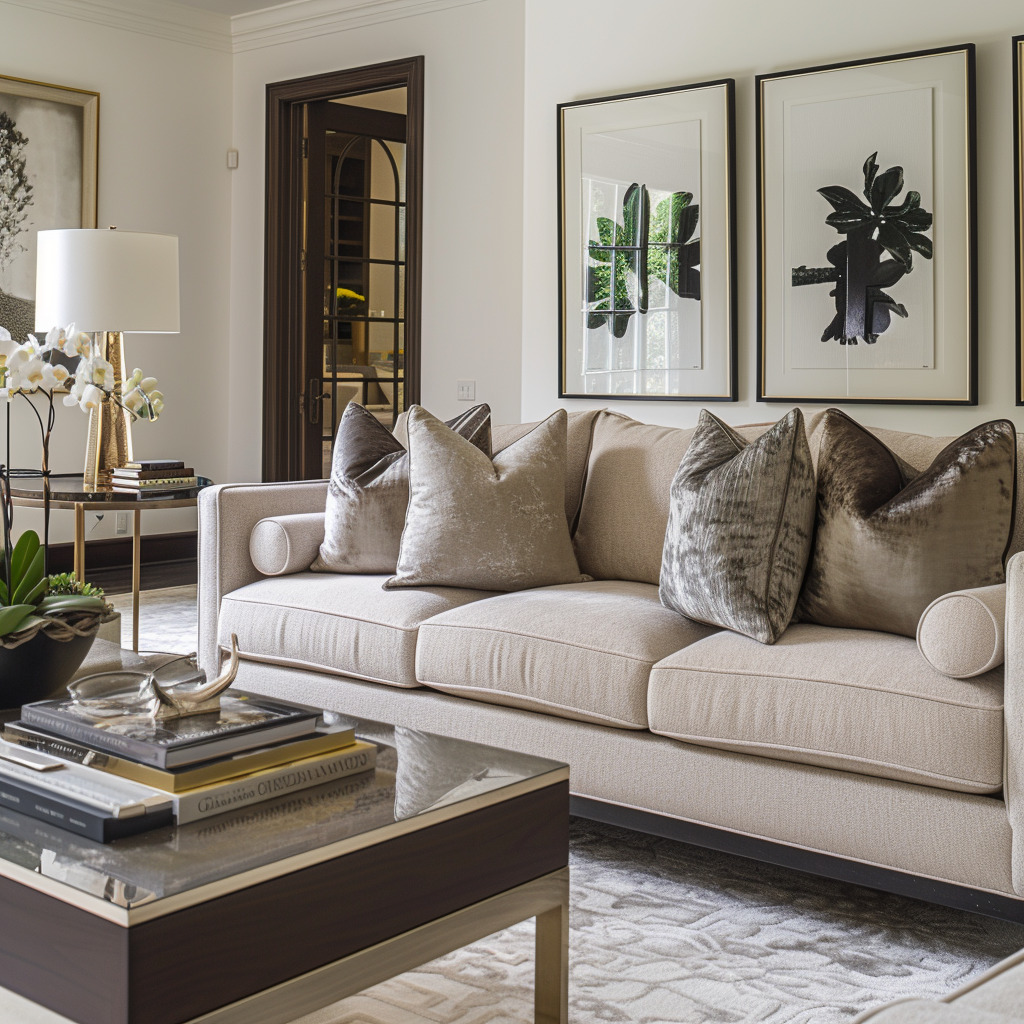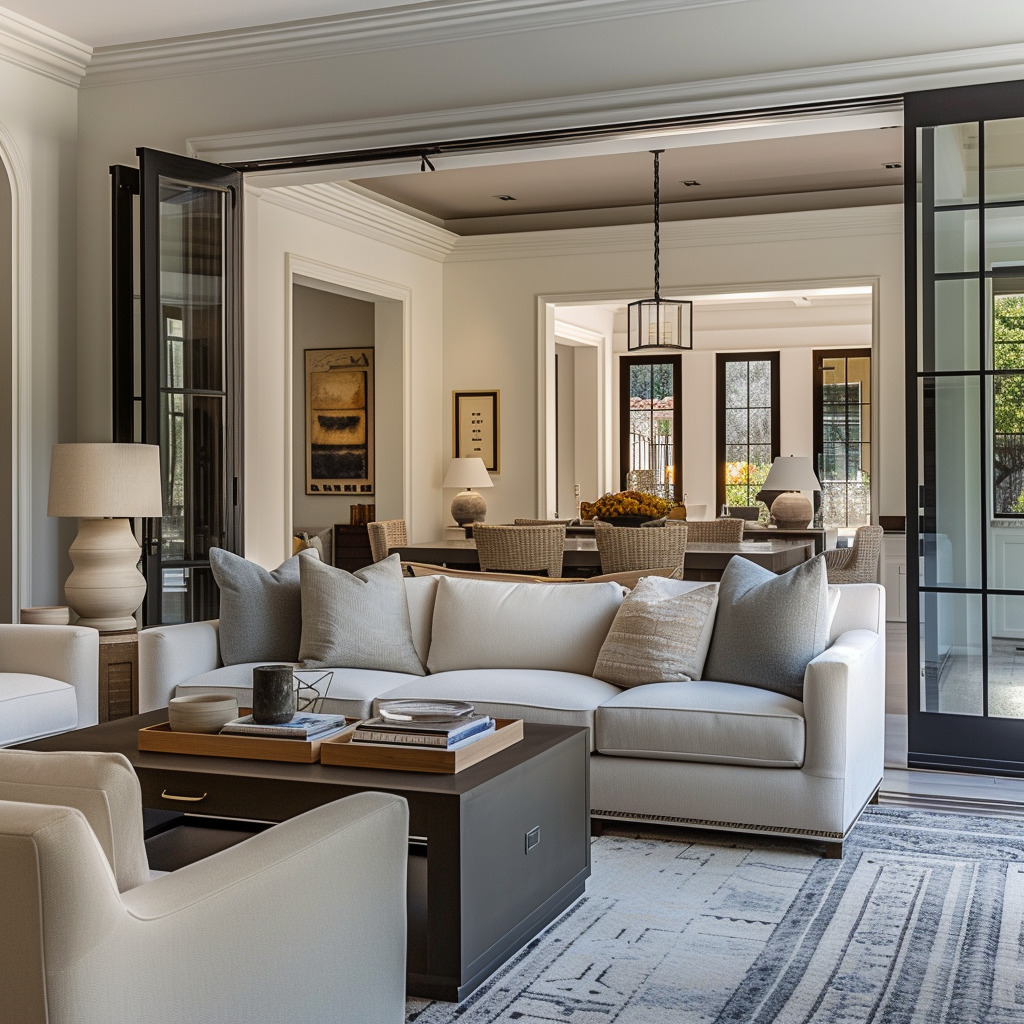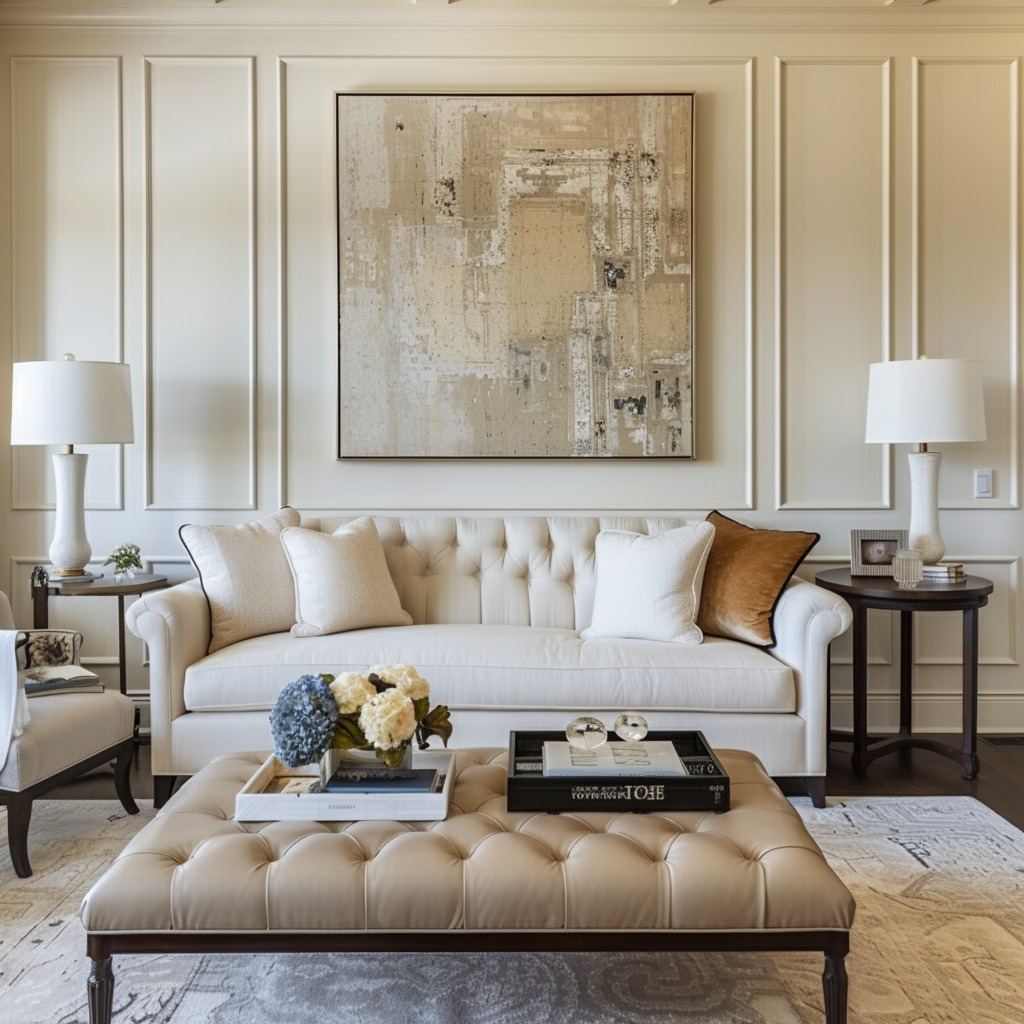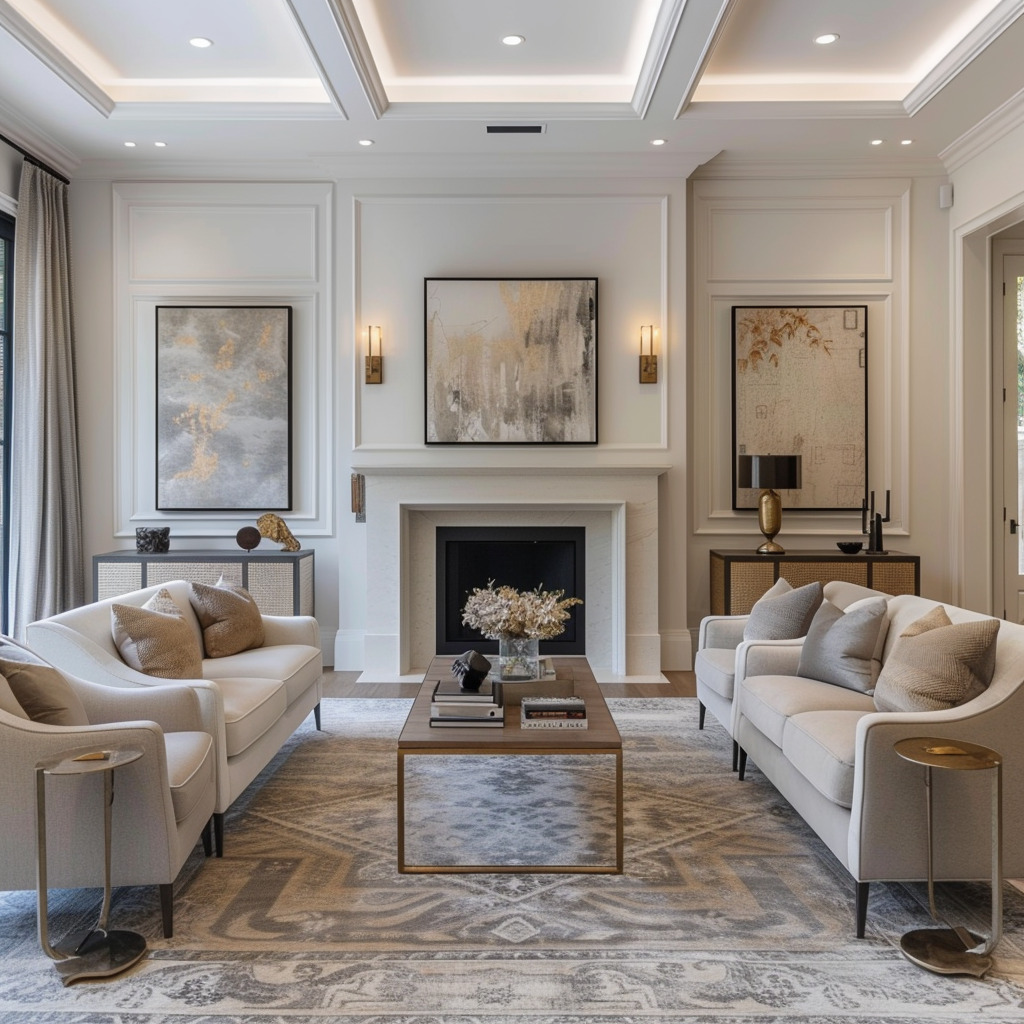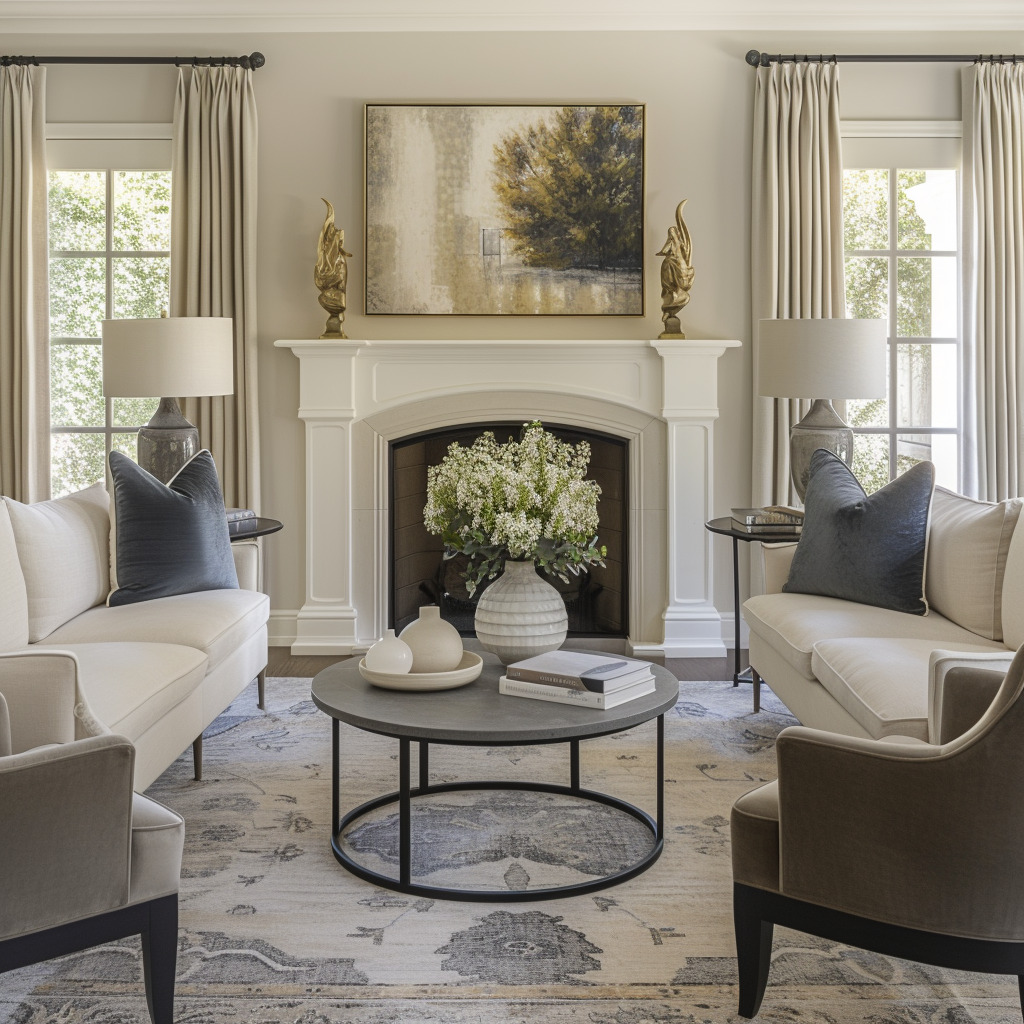Transitional interior design strikes a beautiful balance between the warmth of traditional aesthetics and the simplicity of modern design, forging a timeless elegance in any space. This style is distinguished by a blend of six core features that define its character and approach.
The furniture in transitional design merges the comfort of classic pieces with the streamlined form of modern decor. Architectural details, while subtle, play a significant role in adding sophistication without overwhelming the design.A rich variety of textures is employed to bring warmth and depth, often achieved through fabrics and finishings that invite touch.
Patterns in transitional spaces are intentionally understated, often geometric or gently floral, weaving complexity into the design without becoming overpowering. Lighting is layered and functional, enhancing the space’s elegance with fixtures that make a statement in their simplicity.Finally, transitional design promotes a seamless flow between indoors and out, with natural light and views playing a pivotal role in the overall ambiance.
Furniture Style
Transitional living rooms often feature furniture with simple yet sophisticated lines, devoid of excessive ornamentation. The furniture typically combines the comfort and warmth of traditional style with the clean profiles and understated colors of contemporary design.The sofas and chairs have a noticeable plushness, ensuring that comfort is not sacrificed for style. The silhouettes of the furniture are streamlined, which adds a modern touch to the otherwise classic shapes.This is seen in the tapered legs of chairs and the low, clean lines of the sofas.
The upholstery is consistently in neutral shades, which can range from soft beiges to warm greys, creating a canvas for texture and accent pieces to play a role. Materials like leather and textiles are selected not just for their texture and durability, but also for the way they contribute to the overall feel of the room.The textures of the upholstery vary from smooth and buttery to richly woven, adding a tactile dimension to the spaces.
Seating arrangements are designed for comfort and functionality, with plush sofas and armchairs that invite relaxation. The seating is often arranged to facilitate conversation, with furniture pieces facing each other or arranged in a U-shape.The interiors show how each seating area is anchored by a central coffee table, often in a contrasting material like dark wood or metal, to provide balance and a place for decorative items.
In terms of realization in one’s own interior, to achieve this furniture style, one should seek out pieces that offer both comfort and clean design. Selecting high-quality materials and neutral colors for large furniture items will create a versatile foundation.One can then add personal flair with accent pillows, throws, and unique decorative items that can be easily changed out to update the look without altering the larger pieces. The key is to blend the furniture seamlessly with both traditional and contemporary elements already present in the space, ensuring a cohesive and inviting atmosphere.
Architectural Elements
This design style incorporates architectural features that add character and detail without overpowering the space. Crown moldings, columns, tray ceilings, and archways are common, often painted in muted tones to blend with the room’s overall neutral scheme.These elements bridge the gap between traditional opulence and modern simplicity. We can see how these architectural features are subtly integrated.The crown moldings are neither too wide nor intricately detailed, but they gracefully outline the ceiling, bringing a refined finish to the rooms. The archways are generously proportioned, promoting an open flow between spaces, which is a key aspect of transitional design.
Columns and tray ceilings are used as focal points, contributing to the room’s dimension and depth. In the rooms depicted, the columns are sleek, without the fluting or capitals seen in classical architecture, while the tray ceilings feature simple recesses that add a sense of height and space.The neutral paint on these architectural features serves not only to blend them into the design but also to highlight their form and craftsmanship.
To realize these architectural elements in one’s own space, it is important to keep the scale and proportion in mind. Subtle enhancements like adding a simple crown molding or creating a tray ceiling effect can have a significant impact.Painting these features in the same color as the walls can provide a seamless look that complements the rest of the décor. For those looking to incorporate archways or columns, the key is to ensure that these elements align with the existing lines and openings of the space, creating a natural transition from one area to another.
If adding new architectural features isn’t feasible, one can create the illusion of them through strategic painting techniques or the use of applied moldings. Stick-on or applied moldings can mimic the look of a paneled wall or ceiling detail without the need for structural changes.Lighter shades can make these features stand out, while darker shades can create a more subtle, recessed look. It’s about finding the right balance that complements both the classical and contemporary pieces in the room, enhancing the transitional style’s blend of eras.
Mix of Textures
Transitional living rooms exhibit a rich variety of textures, which add depth and interest to the space. Smooth leather, plush velvet, soft wool, and coarse linen might all coexist harmoniously within the room.The textures are layered in a way that is visually appealing and tactilely inviting, from the furniture to the throw pillows and area rugs. This principle is evident in the selection of furnishings and décor.For example, we see the juxtaposition of sleek leather chairs against the plushness of thick, woven rugs, which adds a complex, tactile experience to the space. There’s a careful balance between refinement and comfort, with the textures providing both a visual and physical warmth.
Accent pillows are often in a mix of fabrics, some with a sheen and others with a matte finish, contributing to the layered texture effect. The smooth, cool surface of a leather ottoman contrasts with the soft, inviting fabric of a sofa.Additionally, the use of decorative throws on seating areas not only serves a functional purpose but also introduces new textures to the space. Artwork and wall decor add further dimension; some pieces have a gloss finish, while others are matte or textured, suggesting depth even on flat surfaces.
To achieve a similar mix of textures in your own space, consider starting with a base of neutral-toned furniture and then layering different materials through your accent pieces. A tactile rug can serve as a foundation for the room, while throw pillows in various fabrics can be easily interchanged to create different moods or update the space with the seasons.Incorporating a mix of metals through light fixtures or decorative items can also add texture, as can the addition of plants or other organic elements which provide a natural contrast to manufactured materials.
When selecting textures, consider the balance of the room as a whole. A heavy wool throw might pair well with a sleek leather chair, while a velvet pillow could complement a linen sofa.The key is in the mix—not too much of one texture or too little of another. This balance ensures that the room feels thoughtfully curated and cohesive.It’s also important to consider the practicality of each texture for your lifestyle; for instance, easily cleanable surfaces in high-traffic areas, and more luxurious textures in spaces reserved for relaxation. The goal is to create a space that appeals to the senses while maintaining the understated elegance of transitional design.
Subtle Patterns
Patterns in transitional design are generally subdued and tend to favor geometric shapes or understated florals. They are integrated through area rugs, throw pillows, and accent pieces.The patterns are not the focal point but rather a complementary element that adds complexity to the neutral color scheme. This concept is executed with precision.The area rugs display gentle, abstract patterns that do not dominate but rather ground the furniture, adding a layer of sophistication. Throw pillows feature a mix of patterns, from simple stripes to delicate paisleys, which work together without clashing, due to their muted tones and restrained designs.
Wall art also contributes to this pattern play, with abstract pieces that imply motion and texture without overwhelming with bright colors or busy lines. Accent pieces like vases and lamps provide opportunities to introduce pattern in a subtle, yet impactful way.For instance, a lamp base might have a textured pattern that complements a solid-colored shade. In one of the rooms, even the ceiling has a pattern with the subtle use of plasterwork that adds dimension without heaviness.
To incorporate subtle patterns into your interior, start by choosing one or two patterned pieces as accents rather than centerpieces. A patterned ottoman or a set of patterned drapes can introduce visual interest without overwhelming the space.When selecting patterns, consider scale; smaller, tighter patterns can be easier to blend than larger, more graphic ones. For a harmonious look, repeat the pattern in small touches throughout the space, such as in the napkins on the dining table, the artwork on the walls, or the pillows on the couch.
Remember that patterns can also come from the natural grain in wood flooring or furniture, the veining in marble countertops, or the texture in woven baskets. These natural patterns contribute to the layered look that is a hallmark of transitional style.By keeping the patterns subtle and complementary, you can ensure that they will stand the test of time and can be easily updated or changed if desired. The aim is to create a sophisticated environment where patterns act as an intriguing backdrop to the life that unfolds within the space.
Lighting and Accessories
Lighting in transitional interiors is both functional and decorative. A mix of floor lamps, table lamps, and overhead lighting fixtures are used to illuminate the room evenly.The designs of these fixtures lean towards sleek and often feature metallic finishes. Accessories are used sparingly, with attention to their quality and impact on the room.Mirrors, vases, and modest artwork contribute to the room’s elegance without cluttering the space. We can observe a consistent approach to lighting that underscores the importance of a well-lit space.
Overhead fixtures, such as recessed lights, provide a blanket of ambient lighting that’s both soft and wide-reaching. Statement pieces like chandeliers or pendants act as sculptural elements, offering visual interest while also performing their primary illuminative function.
Table lamps with ceramic or metallic bases are placed on side tables, adding layers of light that can be adjusted according to the time of day or the desired ambiance. Floor lamps with slim profiles stand gracefully beside sofas and armchairs, their height complementing the vertical lines of the architecture.The use of dimmers is apparent in the warm glow that emanates from various corners, suggesting the flexibility of these lighting schemes to shift from bright and invigorating to soft and intimate.
Accessories are curated with a discerning eye. They’re chosen not just for their aesthetic value but also for the stories they tell or the personal significance they may hold.Mirrors are strategically placed to reflect light and visually expand the space, with frames that range from minimalist to slightly ornate. Artwork is displayed in simple frames that don’t distract from the work itself, and vases are of high-quality materials, their forms ranging from geometric to organic, adding a tactile dimension.
To incorporate lighting and accessories into a transitional interior with similar finesse, one should consider the scale and proportion of the lighting fixtures to the room’s size and ceiling height. Choosing lamps with a mix of textures and finishes can add depth to the space.The key with accessories is restraint; each piece should be selected for its ability to enhance the overall design narrative. When accessorizing, think in terms of balance and composition.Group smaller items together to create a cohesive vignette, and allow for negative space to keep the room from feeling cluttered.
Mirrors can be more than just reflective surfaces; consider their shape and frame as part of the overall design. A tall, lean mirror can emphasize the height of a room, while a round mirror can soften a space dominated by straight lines.As for artwork, opt for pieces that resonate with you personally but maintain a harmonious color palette or theme that complements the transitional style. The aim is to create a space that feels thoughtfully composed, where both lighting and accessories play their role in crafting an atmosphere of understated luxury.
Blending of Indoor and Outdoor Elements
Transitional living rooms often feature large windows, French doors, or sliding glass doors that connect the indoors with the outdoors. These elements provide natural light and views that can be integral to the room’s design, emphasizing a connection with nature.The abundance of natural light is a unifying feature, where expansive windows and doors not only bring in sunlight but also create a seamless transition between the interior and the exterior. This design choice suggests an embrace of the outdoor environment, making it a backdrop to the indoor space.
The window treatments are carefully selected to complement both the interior and the view of the outside, often using sheer, lightweight fabrics that allow light to filter through while still offering privacy. Draperies, when used, are typically in a neutral palette, and they hang from the ceiling to the floor, accentuating the height of the rooms and the grandeur of the windows.The outdoor spaces themselves are often designed as an extension of the interior, with patio furniture and outdoor rugs that mirror the style and comfort of the indoor seating.
To achieve this blend of indoor and outdoor elements in your own home, consider how your living space can be oriented to maximize the views and natural light from windows or doors. Use window treatments that can be easily drawn back to take full advantage of the light during the day and provide privacy when needed.Incorporating indoor plants can also enhance the connection to nature, bringing a bit of the outside in.
For those with limited natural light or smaller windows, strategically placed mirrors can reflect light and landscape, simulating the effect of larger windows. If possible, create an outdoor seating area that aligns with the interior decor to extend the living space outside, using similar colors, materials, or textures.This will not only enhance the sense of spaciousness but also encourage the flow of indoor and outdoor living. The goal is to design a space that celebrates natural light and the beauty of the outdoors, making it a fundamental component of the transitional living experience.
In conclusion, transitional interior design offers a versatile and timeless approach that harmoniously blends the best of both traditional and contemporary styles. By focusing on a sophisticated mix of elements, this style achieves a balance that feels both fresh and familiar, elegant yet approachable.Whether through the careful selection of furniture, the strategic use of texture and patterns, or the integration of lighting and outdoor elements, transitional design creates spaces that are both functional and aesthetically pleasing.


